Functions and Purpose of HRM in Tesco
VerifiedAdded on 2023/01/16
|25
|7898
|29
AI Summary
This report covers functions and purpose of HRM along with internal and external recruitment and selection process in Tesco.
Contribute Materials
Your contribution can guide someone’s learning journey. Share your
documents today.
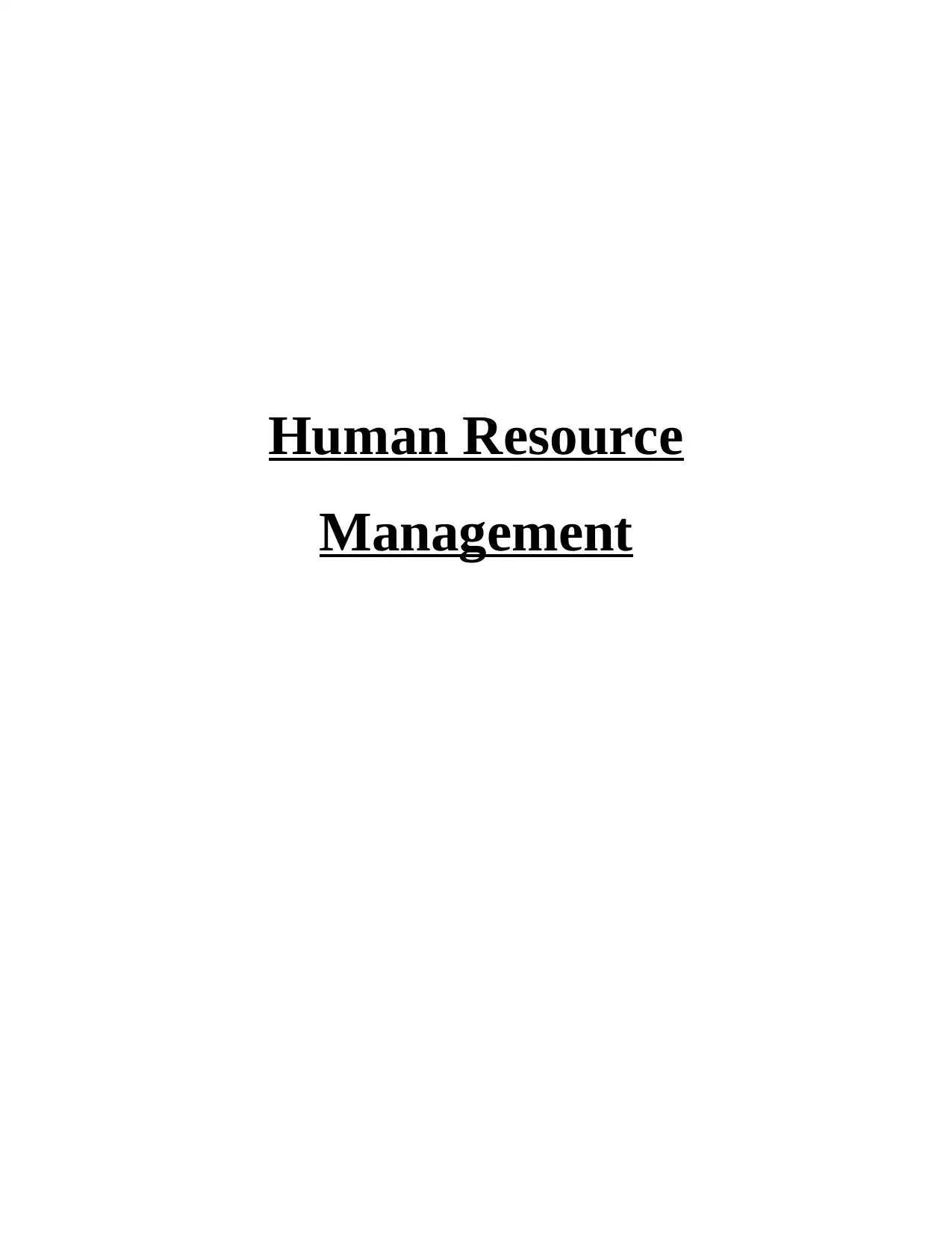
Human Resource
Management
Management
Secure Best Marks with AI Grader
Need help grading? Try our AI Grader for instant feedback on your assignments.

Table of Contents
INTRODUCTION...........................................................................................................................3
TASK 1............................................................................................................................................3
P1 Purpose and the functions of HRM...................................................................................3
P2 Strengths and weaknesses of recruitment and selection approaches................................6
TASK 2............................................................................................................................................9
P3 & P4 Benefits of HRM practices for employer and employee and Effectiveness of HRM
practices in raising organisational profit and productivity.....................................................9
TASK 3..........................................................................................................................................14
P5 Importance of employee relations and influence on HRM decision making..................14
P6 Elements of employment legislation and influence on HRM decision making..............16
TASK 4..........................................................................................................................................17
P7 Application of HRM practices in workplace context.....................................................17
CONCLUSION..............................................................................................................................23
REFERENCES..............................................................................................................................24
INTRODUCTION...........................................................................................................................3
TASK 1............................................................................................................................................3
P1 Purpose and the functions of HRM...................................................................................3
P2 Strengths and weaknesses of recruitment and selection approaches................................6
TASK 2............................................................................................................................................9
P3 & P4 Benefits of HRM practices for employer and employee and Effectiveness of HRM
practices in raising organisational profit and productivity.....................................................9
TASK 3..........................................................................................................................................14
P5 Importance of employee relations and influence on HRM decision making..................14
P6 Elements of employment legislation and influence on HRM decision making..............16
TASK 4..........................................................................................................................................17
P7 Application of HRM practices in workplace context.....................................................17
CONCLUSION..............................................................................................................................23
REFERENCES..............................................................................................................................24
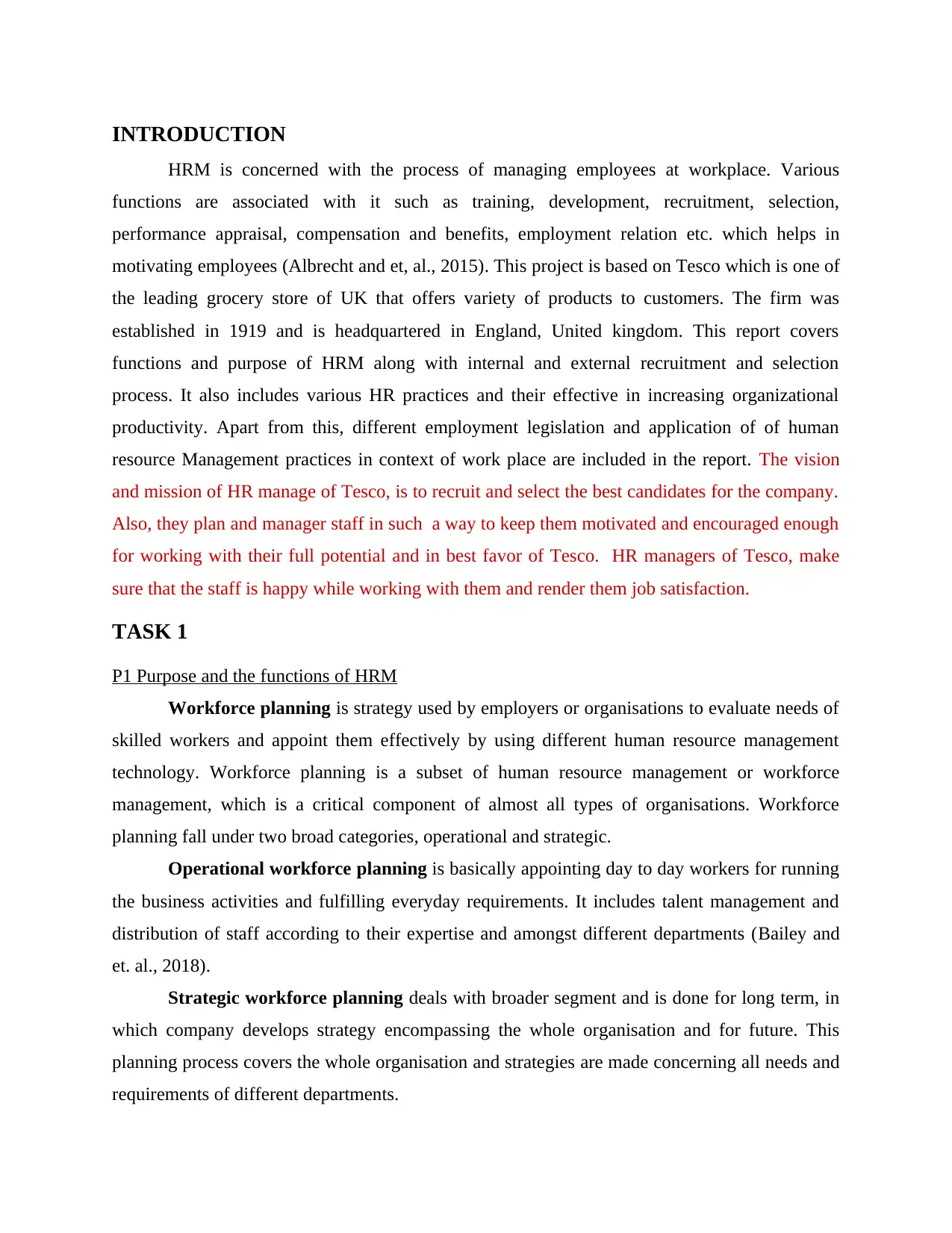
INTRODUCTION
HRM is concerned with the process of managing employees at workplace. Various
functions are associated with it such as training, development, recruitment, selection,
performance appraisal, compensation and benefits, employment relation etc. which helps in
motivating employees (Albrecht and et, al., 2015). This project is based on Tesco which is one of
the leading grocery store of UK that offers variety of products to customers. The firm was
established in 1919 and is headquartered in England, United kingdom. This report covers
functions and purpose of HRM along with internal and external recruitment and selection
process. It also includes various HR practices and their effective in increasing organizational
productivity. Apart from this, different employment legislation and application of of human
resource Management practices in context of work place are included in the report. The vision
and mission of HR manage of Tesco, is to recruit and select the best candidates for the company.
Also, they plan and manager staff in such a way to keep them motivated and encouraged enough
for working with their full potential and in best favor of Tesco. HR managers of Tesco, make
sure that the staff is happy while working with them and render them job satisfaction.
TASK 1
P1 Purpose and the functions of HRM
Workforce planning is strategy used by employers or organisations to evaluate needs of
skilled workers and appoint them effectively by using different human resource management
technology. Workforce planning is a subset of human resource management or workforce
management, which is a critical component of almost all types of organisations. Workforce
planning fall under two broad categories, operational and strategic.
Operational workforce planning is basically appointing day to day workers for running
the business activities and fulfilling everyday requirements. It includes talent management and
distribution of staff according to their expertise and amongst different departments (Bailey and
et. al., 2018).
Strategic workforce planning deals with broader segment and is done for long term, in
which company develops strategy encompassing the whole organisation and for future. This
planning process covers the whole organisation and strategies are made concerning all needs and
requirements of different departments.
HRM is concerned with the process of managing employees at workplace. Various
functions are associated with it such as training, development, recruitment, selection,
performance appraisal, compensation and benefits, employment relation etc. which helps in
motivating employees (Albrecht and et, al., 2015). This project is based on Tesco which is one of
the leading grocery store of UK that offers variety of products to customers. The firm was
established in 1919 and is headquartered in England, United kingdom. This report covers
functions and purpose of HRM along with internal and external recruitment and selection
process. It also includes various HR practices and their effective in increasing organizational
productivity. Apart from this, different employment legislation and application of of human
resource Management practices in context of work place are included in the report. The vision
and mission of HR manage of Tesco, is to recruit and select the best candidates for the company.
Also, they plan and manager staff in such a way to keep them motivated and encouraged enough
for working with their full potential and in best favor of Tesco. HR managers of Tesco, make
sure that the staff is happy while working with them and render them job satisfaction.
TASK 1
P1 Purpose and the functions of HRM
Workforce planning is strategy used by employers or organisations to evaluate needs of
skilled workers and appoint them effectively by using different human resource management
technology. Workforce planning is a subset of human resource management or workforce
management, which is a critical component of almost all types of organisations. Workforce
planning fall under two broad categories, operational and strategic.
Operational workforce planning is basically appointing day to day workers for running
the business activities and fulfilling everyday requirements. It includes talent management and
distribution of staff according to their expertise and amongst different departments (Bailey and
et. al., 2018).
Strategic workforce planning deals with broader segment and is done for long term, in
which company develops strategy encompassing the whole organisation and for future. This
planning process covers the whole organisation and strategies are made concerning all needs and
requirements of different departments.
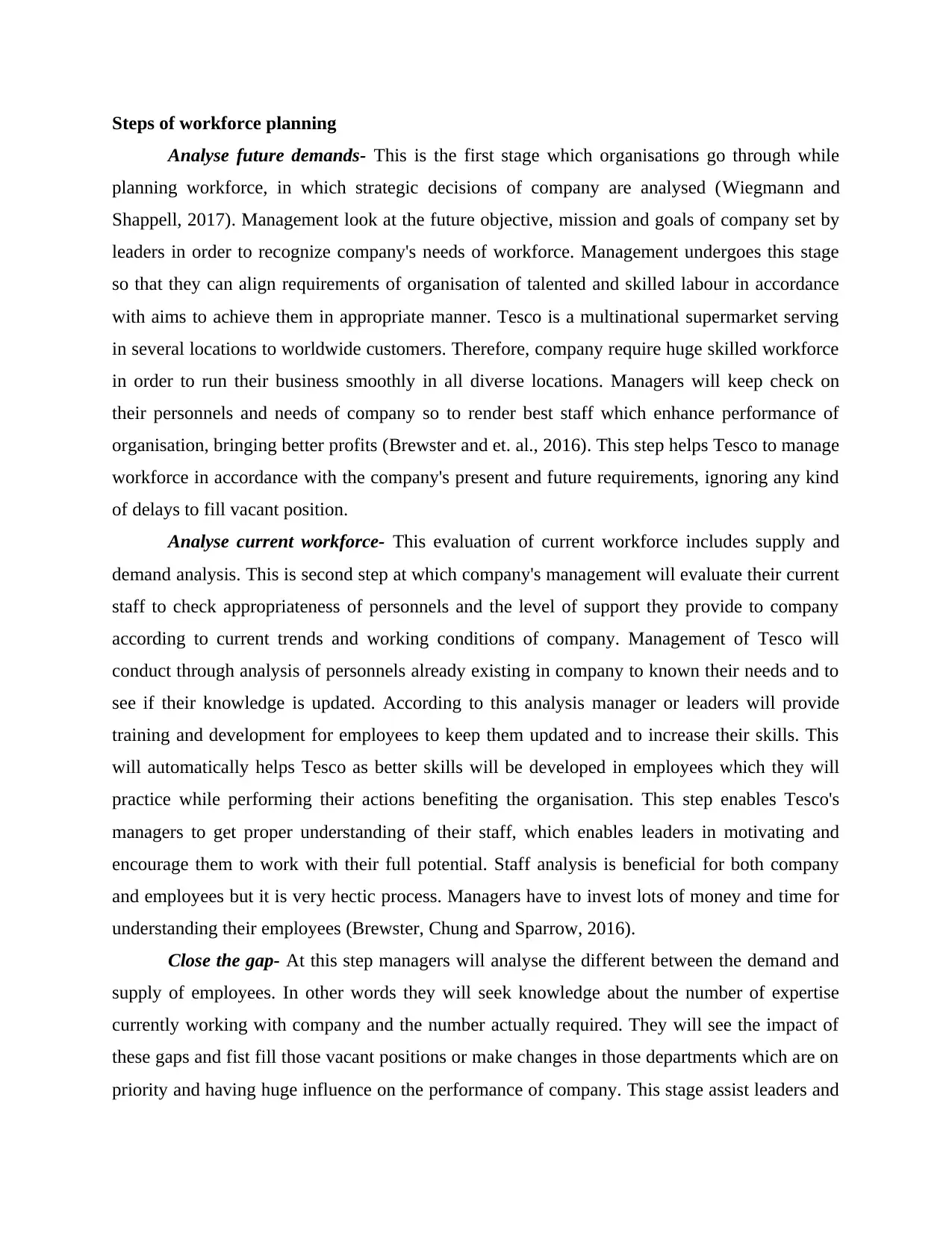
Steps of workforce planning
Analyse future demands- This is the first stage which organisations go through while
planning workforce, in which strategic decisions of company are analysed (Wiegmann and
Shappell, 2017). Management look at the future objective, mission and goals of company set by
leaders in order to recognize company's needs of workforce. Management undergoes this stage
so that they can align requirements of organisation of talented and skilled labour in accordance
with aims to achieve them in appropriate manner. Tesco is a multinational supermarket serving
in several locations to worldwide customers. Therefore, company require huge skilled workforce
in order to run their business smoothly in all diverse locations. Managers will keep check on
their personnels and needs of company so to render best staff which enhance performance of
organisation, bringing better profits (Brewster and et. al., 2016). This step helps Tesco to manage
workforce in accordance with the company's present and future requirements, ignoring any kind
of delays to fill vacant position.
Analyse current workforce- This evaluation of current workforce includes supply and
demand analysis. This is second step at which company's management will evaluate their current
staff to check appropriateness of personnels and the level of support they provide to company
according to current trends and working conditions of company. Management of Tesco will
conduct through analysis of personnels already existing in company to known their needs and to
see if their knowledge is updated. According to this analysis manager or leaders will provide
training and development for employees to keep them updated and to increase their skills. This
will automatically helps Tesco as better skills will be developed in employees which they will
practice while performing their actions benefiting the organisation. This step enables Tesco's
managers to get proper understanding of their staff, which enables leaders in motivating and
encourage them to work with their full potential. Staff analysis is beneficial for both company
and employees but it is very hectic process. Managers have to invest lots of money and time for
understanding their employees (Brewster, Chung and Sparrow, 2016).
Close the gap- At this step managers will analyse the different between the demand and
supply of employees. In other words they will seek knowledge about the number of expertise
currently working with company and the number actually required. They will see the impact of
these gaps and fist fill those vacant positions or make changes in those departments which are on
priority and having huge influence on the performance of company. This stage assist leaders and
Analyse future demands- This is the first stage which organisations go through while
planning workforce, in which strategic decisions of company are analysed (Wiegmann and
Shappell, 2017). Management look at the future objective, mission and goals of company set by
leaders in order to recognize company's needs of workforce. Management undergoes this stage
so that they can align requirements of organisation of talented and skilled labour in accordance
with aims to achieve them in appropriate manner. Tesco is a multinational supermarket serving
in several locations to worldwide customers. Therefore, company require huge skilled workforce
in order to run their business smoothly in all diverse locations. Managers will keep check on
their personnels and needs of company so to render best staff which enhance performance of
organisation, bringing better profits (Brewster and et. al., 2016). This step helps Tesco to manage
workforce in accordance with the company's present and future requirements, ignoring any kind
of delays to fill vacant position.
Analyse current workforce- This evaluation of current workforce includes supply and
demand analysis. This is second step at which company's management will evaluate their current
staff to check appropriateness of personnels and the level of support they provide to company
according to current trends and working conditions of company. Management of Tesco will
conduct through analysis of personnels already existing in company to known their needs and to
see if their knowledge is updated. According to this analysis manager or leaders will provide
training and development for employees to keep them updated and to increase their skills. This
will automatically helps Tesco as better skills will be developed in employees which they will
practice while performing their actions benefiting the organisation. This step enables Tesco's
managers to get proper understanding of their staff, which enables leaders in motivating and
encourage them to work with their full potential. Staff analysis is beneficial for both company
and employees but it is very hectic process. Managers have to invest lots of money and time for
understanding their employees (Brewster, Chung and Sparrow, 2016).
Close the gap- At this step managers will analyse the different between the demand and
supply of employees. In other words they will seek knowledge about the number of expertise
currently working with company and the number actually required. They will see the impact of
these gaps and fist fill those vacant positions or make changes in those departments which are on
priority and having huge influence on the performance of company. This stage assist leaders and
Secure Best Marks with AI Grader
Need help grading? Try our AI Grader for instant feedback on your assignments.
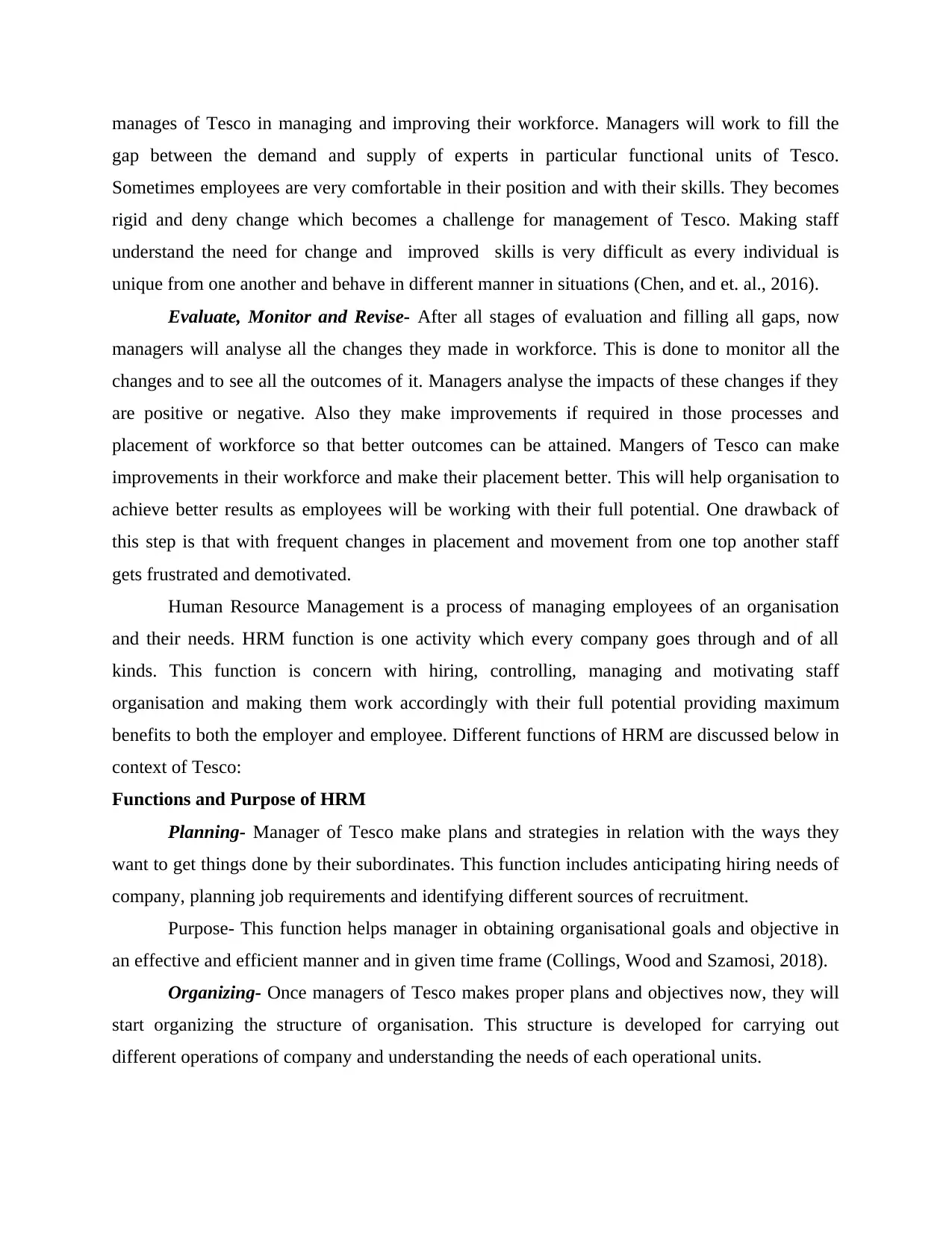
manages of Tesco in managing and improving their workforce. Managers will work to fill the
gap between the demand and supply of experts in particular functional units of Tesco.
Sometimes employees are very comfortable in their position and with their skills. They becomes
rigid and deny change which becomes a challenge for management of Tesco. Making staff
understand the need for change and improved skills is very difficult as every individual is
unique from one another and behave in different manner in situations (Chen, and et. al., 2016).
Evaluate, Monitor and Revise- After all stages of evaluation and filling all gaps, now
managers will analyse all the changes they made in workforce. This is done to monitor all the
changes and to see all the outcomes of it. Managers analyse the impacts of these changes if they
are positive or negative. Also they make improvements if required in those processes and
placement of workforce so that better outcomes can be attained. Mangers of Tesco can make
improvements in their workforce and make their placement better. This will help organisation to
achieve better results as employees will be working with their full potential. One drawback of
this step is that with frequent changes in placement and movement from one top another staff
gets frustrated and demotivated.
Human Resource Management is a process of managing employees of an organisation
and their needs. HRM function is one activity which every company goes through and of all
kinds. This function is concern with hiring, controlling, managing and motivating staff
organisation and making them work accordingly with their full potential providing maximum
benefits to both the employer and employee. Different functions of HRM are discussed below in
context of Tesco:
Functions and Purpose of HRM
Planning- Manager of Tesco make plans and strategies in relation with the ways they
want to get things done by their subordinates. This function includes anticipating hiring needs of
company, planning job requirements and identifying different sources of recruitment.
Purpose- This function helps manager in obtaining organisational goals and objective in
an effective and efficient manner and in given time frame (Collings, Wood and Szamosi, 2018).
Organizing- Once managers of Tesco makes proper plans and objectives now, they will
start organizing the structure of organisation. This structure is developed for carrying out
different operations of company and understanding the needs of each operational units.
gap between the demand and supply of experts in particular functional units of Tesco.
Sometimes employees are very comfortable in their position and with their skills. They becomes
rigid and deny change which becomes a challenge for management of Tesco. Making staff
understand the need for change and improved skills is very difficult as every individual is
unique from one another and behave in different manner in situations (Chen, and et. al., 2016).
Evaluate, Monitor and Revise- After all stages of evaluation and filling all gaps, now
managers will analyse all the changes they made in workforce. This is done to monitor all the
changes and to see all the outcomes of it. Managers analyse the impacts of these changes if they
are positive or negative. Also they make improvements if required in those processes and
placement of workforce so that better outcomes can be attained. Mangers of Tesco can make
improvements in their workforce and make their placement better. This will help organisation to
achieve better results as employees will be working with their full potential. One drawback of
this step is that with frequent changes in placement and movement from one top another staff
gets frustrated and demotivated.
Human Resource Management is a process of managing employees of an organisation
and their needs. HRM function is one activity which every company goes through and of all
kinds. This function is concern with hiring, controlling, managing and motivating staff
organisation and making them work accordingly with their full potential providing maximum
benefits to both the employer and employee. Different functions of HRM are discussed below in
context of Tesco:
Functions and Purpose of HRM
Planning- Manager of Tesco make plans and strategies in relation with the ways they
want to get things done by their subordinates. This function includes anticipating hiring needs of
company, planning job requirements and identifying different sources of recruitment.
Purpose- This function helps manager in obtaining organisational goals and objective in
an effective and efficient manner and in given time frame (Collings, Wood and Szamosi, 2018).
Organizing- Once managers of Tesco makes proper plans and objectives now, they will
start organizing the structure of organisation. This structure is developed for carrying out
different operations of company and understanding the needs of each operational units.
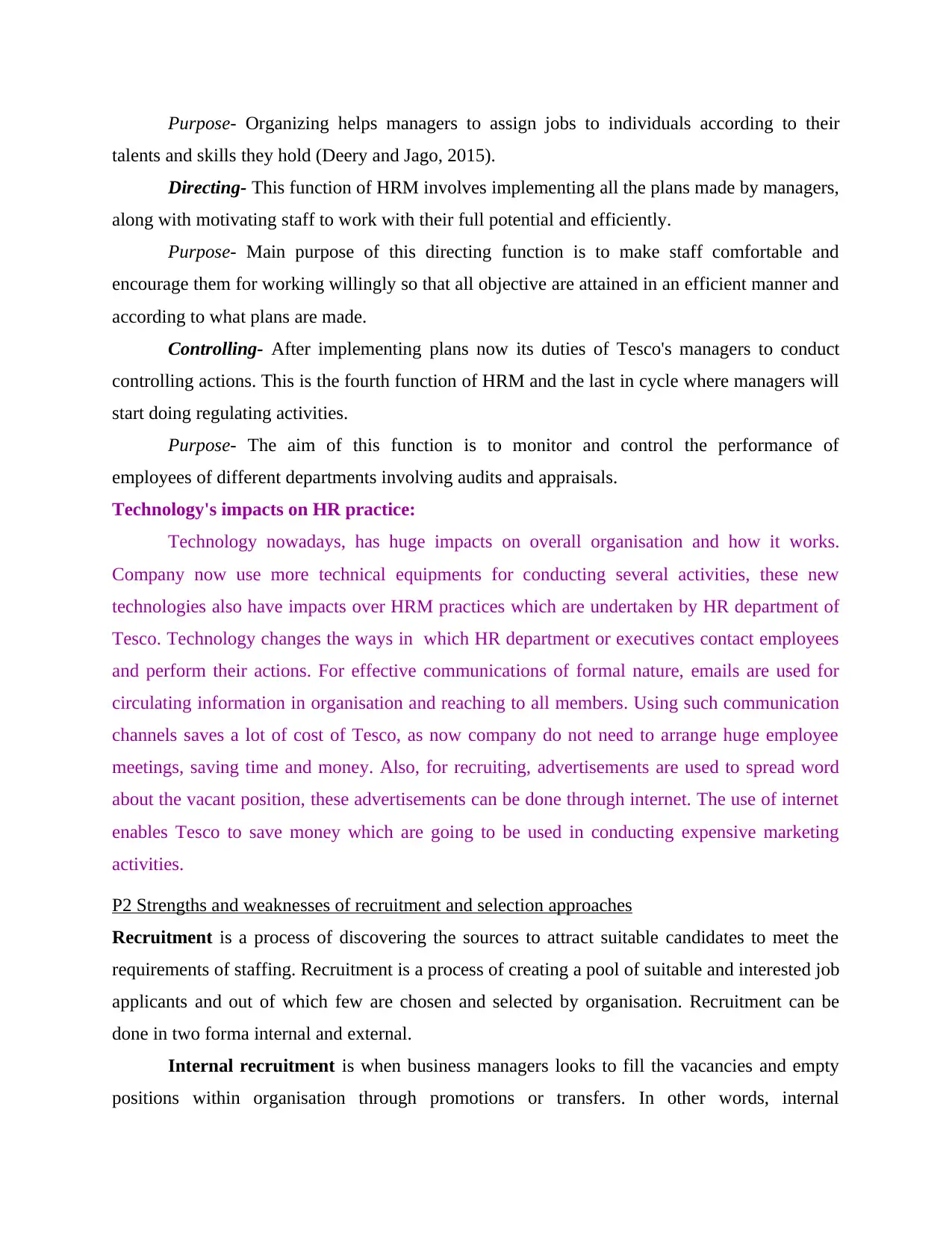
Purpose- Organizing helps managers to assign jobs to individuals according to their
talents and skills they hold (Deery and Jago, 2015).
Directing- This function of HRM involves implementing all the plans made by managers,
along with motivating staff to work with their full potential and efficiently.
Purpose- Main purpose of this directing function is to make staff comfortable and
encourage them for working willingly so that all objective are attained in an efficient manner and
according to what plans are made.
Controlling- After implementing plans now its duties of Tesco's managers to conduct
controlling actions. This is the fourth function of HRM and the last in cycle where managers will
start doing regulating activities.
Purpose- The aim of this function is to monitor and control the performance of
employees of different departments involving audits and appraisals.
Technology's impacts on HR practice:
Technology nowadays, has huge impacts on overall organisation and how it works.
Company now use more technical equipments for conducting several activities, these new
technologies also have impacts over HRM practices which are undertaken by HR department of
Tesco. Technology changes the ways in which HR department or executives contact employees
and perform their actions. For effective communications of formal nature, emails are used for
circulating information in organisation and reaching to all members. Using such communication
channels saves a lot of cost of Tesco, as now company do not need to arrange huge employee
meetings, saving time and money. Also, for recruiting, advertisements are used to spread word
about the vacant position, these advertisements can be done through internet. The use of internet
enables Tesco to save money which are going to be used in conducting expensive marketing
activities.
P2 Strengths and weaknesses of recruitment and selection approaches
Recruitment is a process of discovering the sources to attract suitable candidates to meet the
requirements of staffing. Recruitment is a process of creating a pool of suitable and interested job
applicants and out of which few are chosen and selected by organisation. Recruitment can be
done in two forma internal and external.
Internal recruitment is when business managers looks to fill the vacancies and empty
positions within organisation through promotions or transfers. In other words, internal
talents and skills they hold (Deery and Jago, 2015).
Directing- This function of HRM involves implementing all the plans made by managers,
along with motivating staff to work with their full potential and efficiently.
Purpose- Main purpose of this directing function is to make staff comfortable and
encourage them for working willingly so that all objective are attained in an efficient manner and
according to what plans are made.
Controlling- After implementing plans now its duties of Tesco's managers to conduct
controlling actions. This is the fourth function of HRM and the last in cycle where managers will
start doing regulating activities.
Purpose- The aim of this function is to monitor and control the performance of
employees of different departments involving audits and appraisals.
Technology's impacts on HR practice:
Technology nowadays, has huge impacts on overall organisation and how it works.
Company now use more technical equipments for conducting several activities, these new
technologies also have impacts over HRM practices which are undertaken by HR department of
Tesco. Technology changes the ways in which HR department or executives contact employees
and perform their actions. For effective communications of formal nature, emails are used for
circulating information in organisation and reaching to all members. Using such communication
channels saves a lot of cost of Tesco, as now company do not need to arrange huge employee
meetings, saving time and money. Also, for recruiting, advertisements are used to spread word
about the vacant position, these advertisements can be done through internet. The use of internet
enables Tesco to save money which are going to be used in conducting expensive marketing
activities.
P2 Strengths and weaknesses of recruitment and selection approaches
Recruitment is a process of discovering the sources to attract suitable candidates to meet the
requirements of staffing. Recruitment is a process of creating a pool of suitable and interested job
applicants and out of which few are chosen and selected by organisation. Recruitment can be
done in two forma internal and external.
Internal recruitment is when business managers looks to fill the vacancies and empty
positions within organisation through promotions or transfers. In other words, internal
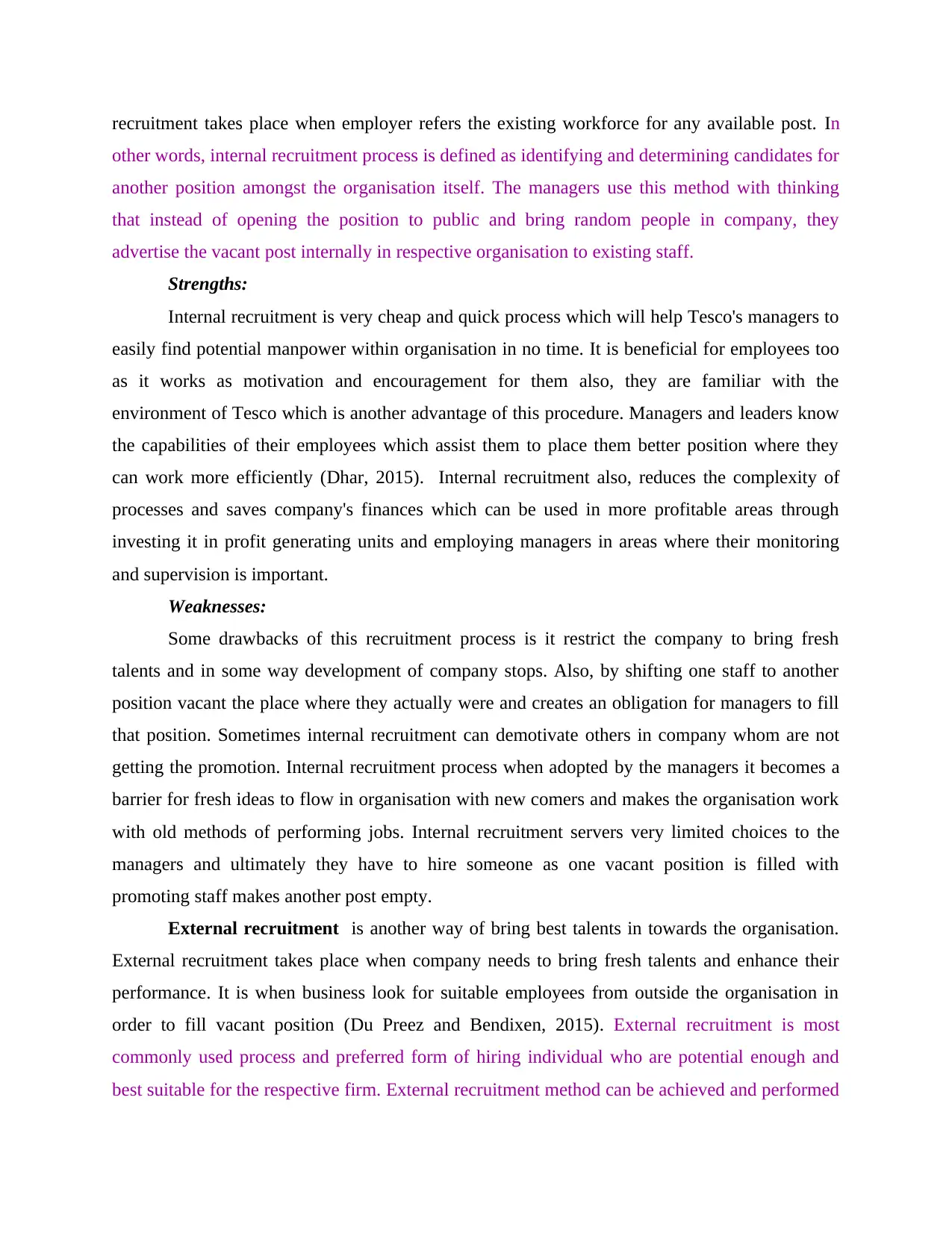
recruitment takes place when employer refers the existing workforce for any available post. In
other words, internal recruitment process is defined as identifying and determining candidates for
another position amongst the organisation itself. The managers use this method with thinking
that instead of opening the position to public and bring random people in company, they
advertise the vacant post internally in respective organisation to existing staff.
Strengths:
Internal recruitment is very cheap and quick process which will help Tesco's managers to
easily find potential manpower within organisation in no time. It is beneficial for employees too
as it works as motivation and encouragement for them also, they are familiar with the
environment of Tesco which is another advantage of this procedure. Managers and leaders know
the capabilities of their employees which assist them to place them better position where they
can work more efficiently (Dhar, 2015). Internal recruitment also, reduces the complexity of
processes and saves company's finances which can be used in more profitable areas through
investing it in profit generating units and employing managers in areas where their monitoring
and supervision is important.
Weaknesses:
Some drawbacks of this recruitment process is it restrict the company to bring fresh
talents and in some way development of company stops. Also, by shifting one staff to another
position vacant the place where they actually were and creates an obligation for managers to fill
that position. Sometimes internal recruitment can demotivate others in company whom are not
getting the promotion. Internal recruitment process when adopted by the managers it becomes a
barrier for fresh ideas to flow in organisation with new comers and makes the organisation work
with old methods of performing jobs. Internal recruitment servers very limited choices to the
managers and ultimately they have to hire someone as one vacant position is filled with
promoting staff makes another post empty.
External recruitment is another way of bring best talents in towards the organisation.
External recruitment takes place when company needs to bring fresh talents and enhance their
performance. It is when business look for suitable employees from outside the organisation in
order to fill vacant position (Du Preez and Bendixen, 2015). External recruitment is most
commonly used process and preferred form of hiring individual who are potential enough and
best suitable for the respective firm. External recruitment method can be achieved and performed
other words, internal recruitment process is defined as identifying and determining candidates for
another position amongst the organisation itself. The managers use this method with thinking
that instead of opening the position to public and bring random people in company, they
advertise the vacant post internally in respective organisation to existing staff.
Strengths:
Internal recruitment is very cheap and quick process which will help Tesco's managers to
easily find potential manpower within organisation in no time. It is beneficial for employees too
as it works as motivation and encouragement for them also, they are familiar with the
environment of Tesco which is another advantage of this procedure. Managers and leaders know
the capabilities of their employees which assist them to place them better position where they
can work more efficiently (Dhar, 2015). Internal recruitment also, reduces the complexity of
processes and saves company's finances which can be used in more profitable areas through
investing it in profit generating units and employing managers in areas where their monitoring
and supervision is important.
Weaknesses:
Some drawbacks of this recruitment process is it restrict the company to bring fresh
talents and in some way development of company stops. Also, by shifting one staff to another
position vacant the place where they actually were and creates an obligation for managers to fill
that position. Sometimes internal recruitment can demotivate others in company whom are not
getting the promotion. Internal recruitment process when adopted by the managers it becomes a
barrier for fresh ideas to flow in organisation with new comers and makes the organisation work
with old methods of performing jobs. Internal recruitment servers very limited choices to the
managers and ultimately they have to hire someone as one vacant position is filled with
promoting staff makes another post empty.
External recruitment is another way of bring best talents in towards the organisation.
External recruitment takes place when company needs to bring fresh talents and enhance their
performance. It is when business look for suitable employees from outside the organisation in
order to fill vacant position (Du Preez and Bendixen, 2015). External recruitment is most
commonly used process and preferred form of hiring individual who are potential enough and
best suitable for the respective firm. External recruitment method can be achieved and performed
Paraphrase This Document
Need a fresh take? Get an instant paraphrase of this document with our AI Paraphraser
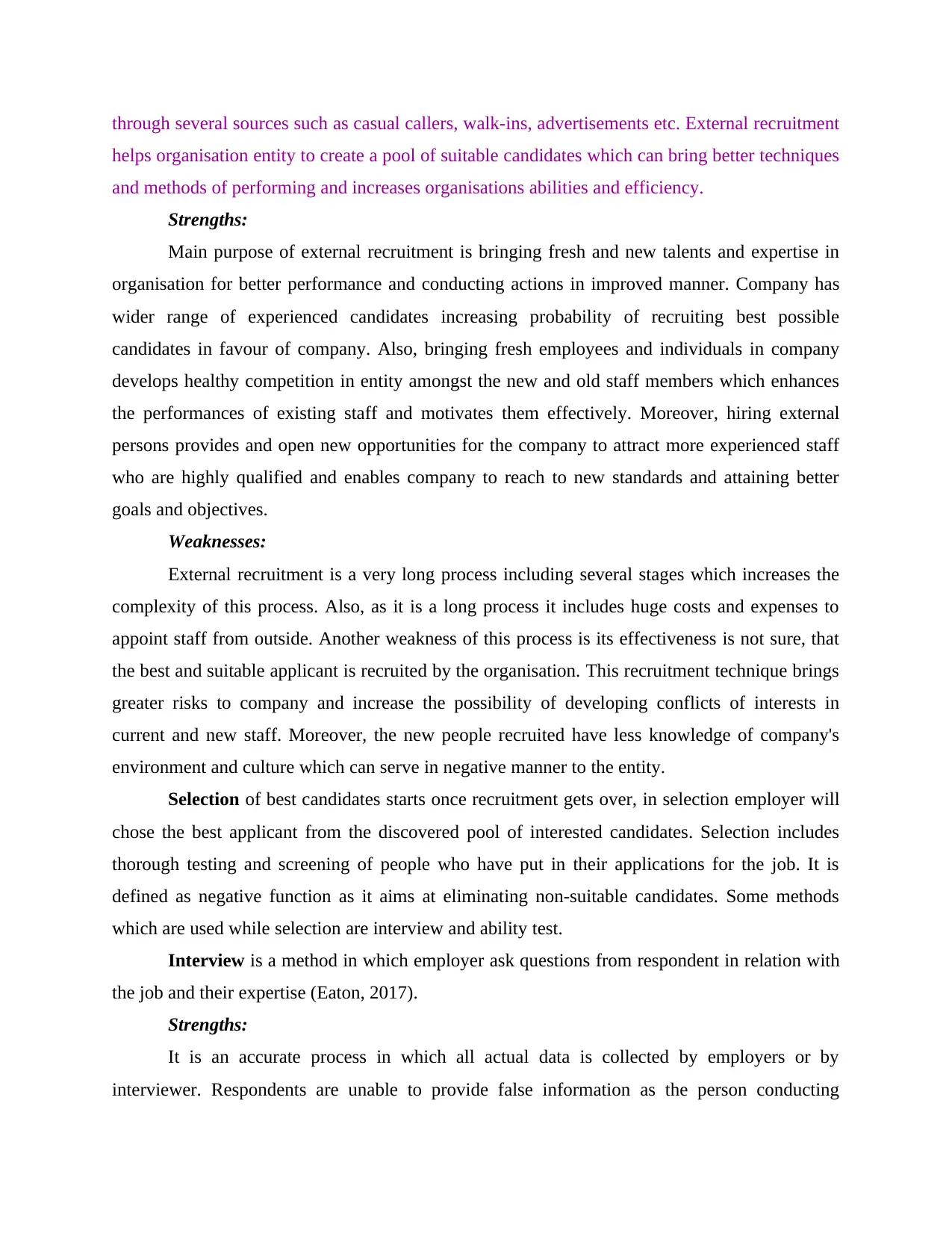
through several sources such as casual callers, walk-ins, advertisements etc. External recruitment
helps organisation entity to create a pool of suitable candidates which can bring better techniques
and methods of performing and increases organisations abilities and efficiency.
Strengths:
Main purpose of external recruitment is bringing fresh and new talents and expertise in
organisation for better performance and conducting actions in improved manner. Company has
wider range of experienced candidates increasing probability of recruiting best possible
candidates in favour of company. Also, bringing fresh employees and individuals in company
develops healthy competition in entity amongst the new and old staff members which enhances
the performances of existing staff and motivates them effectively. Moreover, hiring external
persons provides and open new opportunities for the company to attract more experienced staff
who are highly qualified and enables company to reach to new standards and attaining better
goals and objectives.
Weaknesses:
External recruitment is a very long process including several stages which increases the
complexity of this process. Also, as it is a long process it includes huge costs and expenses to
appoint staff from outside. Another weakness of this process is its effectiveness is not sure, that
the best and suitable applicant is recruited by the organisation. This recruitment technique brings
greater risks to company and increase the possibility of developing conflicts of interests in
current and new staff. Moreover, the new people recruited have less knowledge of company's
environment and culture which can serve in negative manner to the entity.
Selection of best candidates starts once recruitment gets over, in selection employer will
chose the best applicant from the discovered pool of interested candidates. Selection includes
thorough testing and screening of people who have put in their applications for the job. It is
defined as negative function as it aims at eliminating non-suitable candidates. Some methods
which are used while selection are interview and ability test.
Interview is a method in which employer ask questions from respondent in relation with
the job and their expertise (Eaton, 2017).
Strengths:
It is an accurate process in which all actual data is collected by employers or by
interviewer. Respondents are unable to provide false information as the person conducting
helps organisation entity to create a pool of suitable candidates which can bring better techniques
and methods of performing and increases organisations abilities and efficiency.
Strengths:
Main purpose of external recruitment is bringing fresh and new talents and expertise in
organisation for better performance and conducting actions in improved manner. Company has
wider range of experienced candidates increasing probability of recruiting best possible
candidates in favour of company. Also, bringing fresh employees and individuals in company
develops healthy competition in entity amongst the new and old staff members which enhances
the performances of existing staff and motivates them effectively. Moreover, hiring external
persons provides and open new opportunities for the company to attract more experienced staff
who are highly qualified and enables company to reach to new standards and attaining better
goals and objectives.
Weaknesses:
External recruitment is a very long process including several stages which increases the
complexity of this process. Also, as it is a long process it includes huge costs and expenses to
appoint staff from outside. Another weakness of this process is its effectiveness is not sure, that
the best and suitable applicant is recruited by the organisation. This recruitment technique brings
greater risks to company and increase the possibility of developing conflicts of interests in
current and new staff. Moreover, the new people recruited have less knowledge of company's
environment and culture which can serve in negative manner to the entity.
Selection of best candidates starts once recruitment gets over, in selection employer will
chose the best applicant from the discovered pool of interested candidates. Selection includes
thorough testing and screening of people who have put in their applications for the job. It is
defined as negative function as it aims at eliminating non-suitable candidates. Some methods
which are used while selection are interview and ability test.
Interview is a method in which employer ask questions from respondent in relation with
the job and their expertise (Eaton, 2017).
Strengths:
It is an accurate process in which all actual data is collected by employers or by
interviewer. Respondents are unable to provide false information as the person conducting
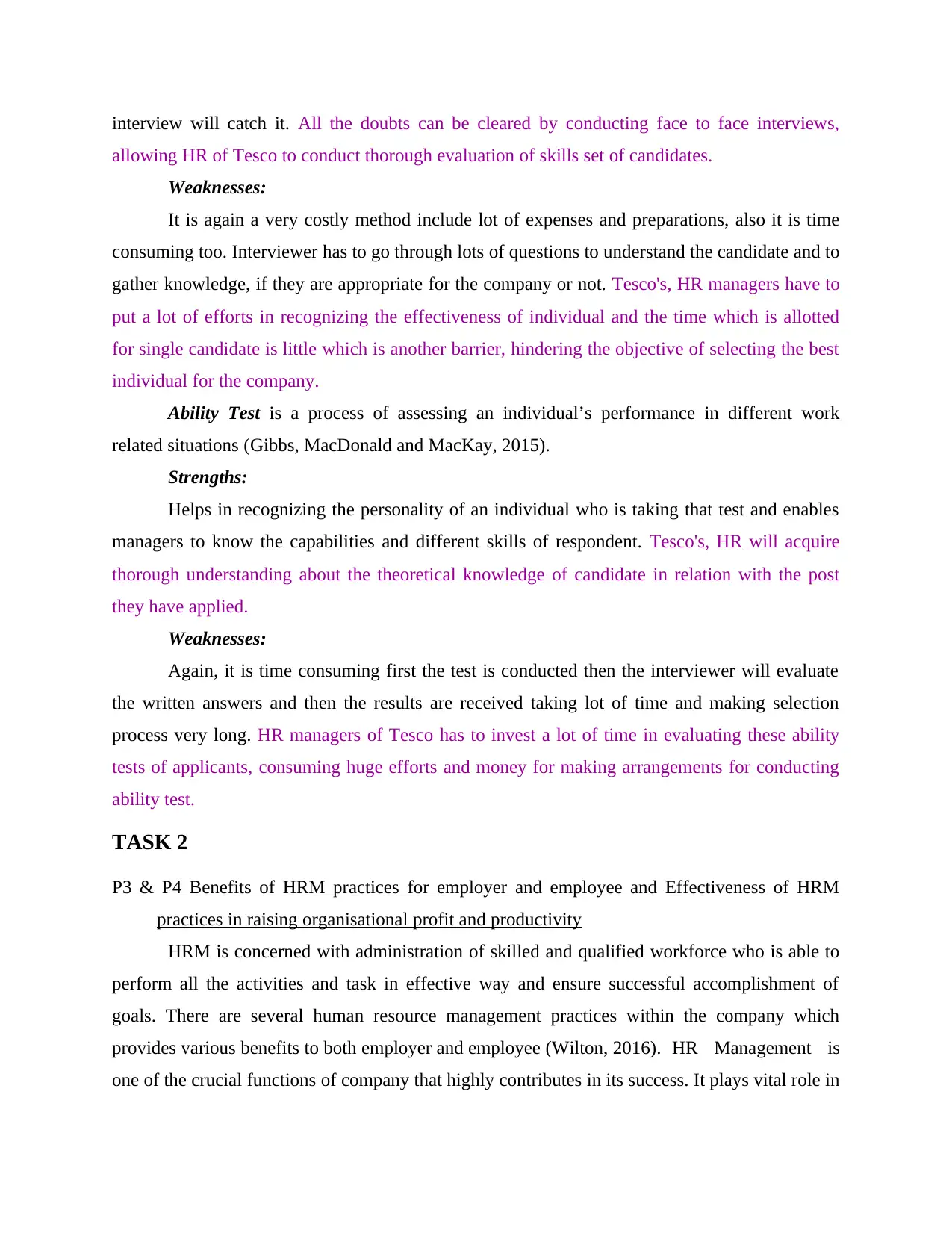
interview will catch it. All the doubts can be cleared by conducting face to face interviews,
allowing HR of Tesco to conduct thorough evaluation of skills set of candidates.
Weaknesses:
It is again a very costly method include lot of expenses and preparations, also it is time
consuming too. Interviewer has to go through lots of questions to understand the candidate and to
gather knowledge, if they are appropriate for the company or not. Tesco's, HR managers have to
put a lot of efforts in recognizing the effectiveness of individual and the time which is allotted
for single candidate is little which is another barrier, hindering the objective of selecting the best
individual for the company.
Ability Test is a process of assessing an individual’s performance in different work
related situations (Gibbs, MacDonald and MacKay, 2015).
Strengths:
Helps in recognizing the personality of an individual who is taking that test and enables
managers to know the capabilities and different skills of respondent. Tesco's, HR will acquire
thorough understanding about the theoretical knowledge of candidate in relation with the post
they have applied.
Weaknesses:
Again, it is time consuming first the test is conducted then the interviewer will evaluate
the written answers and then the results are received taking lot of time and making selection
process very long. HR managers of Tesco has to invest a lot of time in evaluating these ability
tests of applicants, consuming huge efforts and money for making arrangements for conducting
ability test.
TASK 2
P3 & P4 Benefits of HRM practices for employer and employee and Effectiveness of HRM
practices in raising organisational profit and productivity
HRM is concerned with administration of skilled and qualified workforce who is able to
perform all the activities and task in effective way and ensure successful accomplishment of
goals. There are several human resource management practices within the company which
provides various benefits to both employer and employee (Wilton, 2016). HR Management is
one of the crucial functions of company that highly contributes in its success. It plays vital role in
allowing HR of Tesco to conduct thorough evaluation of skills set of candidates.
Weaknesses:
It is again a very costly method include lot of expenses and preparations, also it is time
consuming too. Interviewer has to go through lots of questions to understand the candidate and to
gather knowledge, if they are appropriate for the company or not. Tesco's, HR managers have to
put a lot of efforts in recognizing the effectiveness of individual and the time which is allotted
for single candidate is little which is another barrier, hindering the objective of selecting the best
individual for the company.
Ability Test is a process of assessing an individual’s performance in different work
related situations (Gibbs, MacDonald and MacKay, 2015).
Strengths:
Helps in recognizing the personality of an individual who is taking that test and enables
managers to know the capabilities and different skills of respondent. Tesco's, HR will acquire
thorough understanding about the theoretical knowledge of candidate in relation with the post
they have applied.
Weaknesses:
Again, it is time consuming first the test is conducted then the interviewer will evaluate
the written answers and then the results are received taking lot of time and making selection
process very long. HR managers of Tesco has to invest a lot of time in evaluating these ability
tests of applicants, consuming huge efforts and money for making arrangements for conducting
ability test.
TASK 2
P3 & P4 Benefits of HRM practices for employer and employee and Effectiveness of HRM
practices in raising organisational profit and productivity
HRM is concerned with administration of skilled and qualified workforce who is able to
perform all the activities and task in effective way and ensure successful accomplishment of
goals. There are several human resource management practices within the company which
provides various benefits to both employer and employee (Wilton, 2016). HR Management is
one of the crucial functions of company that highly contributes in its success. It plays vital role in
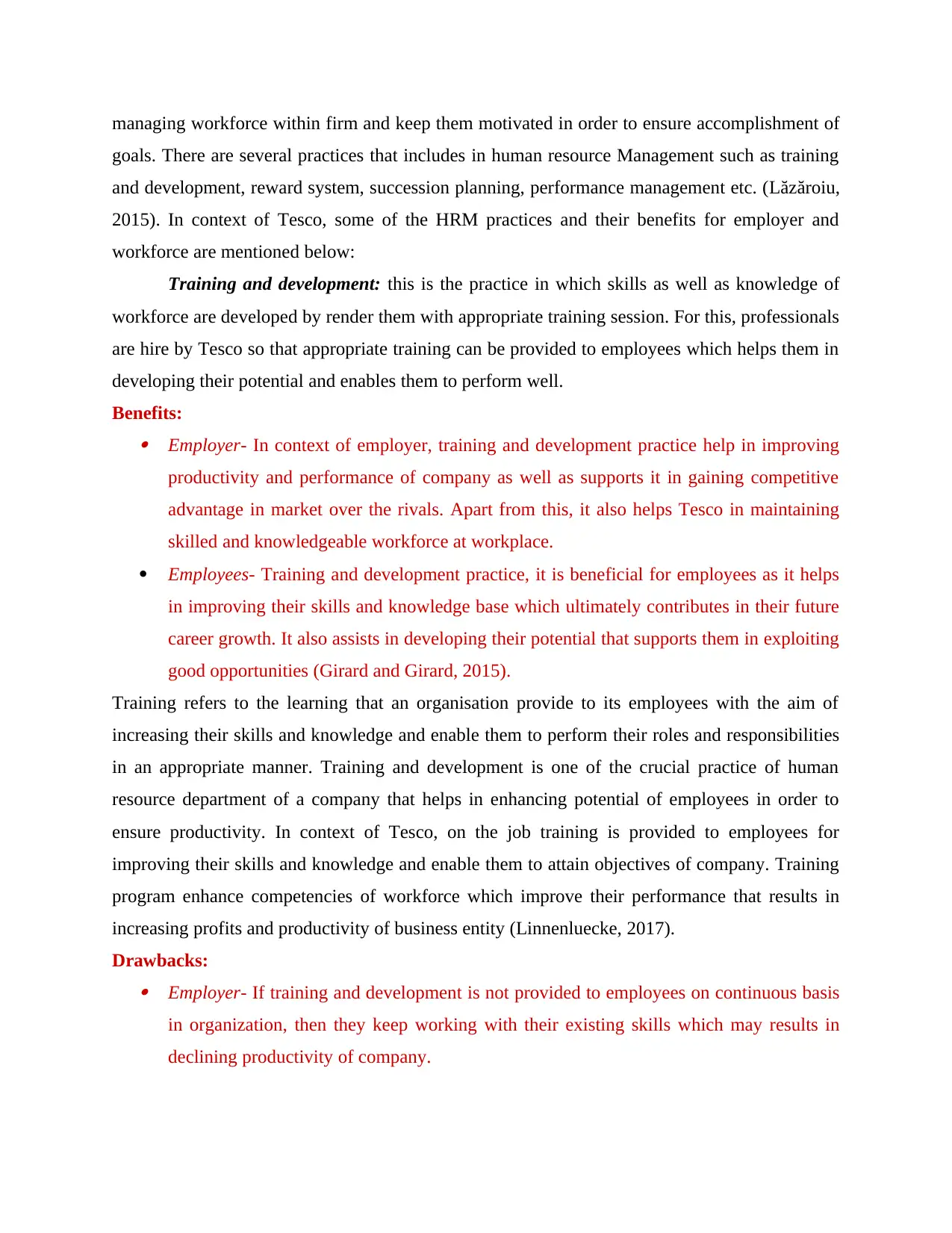
managing workforce within firm and keep them motivated in order to ensure accomplishment of
goals. There are several practices that includes in human resource Management such as training
and development, reward system, succession planning, performance management etc. (Lăzăroiu,
2015). In context of Tesco, some of the HRM practices and their benefits for employer and
workforce are mentioned below:
Training and development: this is the practice in which skills as well as knowledge of
workforce are developed by render them with appropriate training session. For this, professionals
are hire by Tesco so that appropriate training can be provided to employees which helps them in
developing their potential and enables them to perform well.
Benefits: Employer- In context of employer, training and development practice help in improving
productivity and performance of company as well as supports it in gaining competitive
advantage in market over the rivals. Apart from this, it also helps Tesco in maintaining
skilled and knowledgeable workforce at workplace.
Employees- Training and development practice, it is beneficial for employees as it helps
in improving their skills and knowledge base which ultimately contributes in their future
career growth. It also assists in developing their potential that supports them in exploiting
good opportunities (Girard and Girard, 2015).
Training refers to the learning that an organisation provide to its employees with the aim of
increasing their skills and knowledge and enable them to perform their roles and responsibilities
in an appropriate manner. Training and development is one of the crucial practice of human
resource department of a company that helps in enhancing potential of employees in order to
ensure productivity. In context of Tesco, on the job training is provided to employees for
improving their skills and knowledge and enable them to attain objectives of company. Training
program enhance competencies of workforce which improve their performance that results in
increasing profits and productivity of business entity (Linnenluecke, 2017).
Drawbacks: Employer- If training and development is not provided to employees on continuous basis
in organization, then they keep working with their existing skills which may results in
declining productivity of company.
goals. There are several practices that includes in human resource Management such as training
and development, reward system, succession planning, performance management etc. (Lăzăroiu,
2015). In context of Tesco, some of the HRM practices and their benefits for employer and
workforce are mentioned below:
Training and development: this is the practice in which skills as well as knowledge of
workforce are developed by render them with appropriate training session. For this, professionals
are hire by Tesco so that appropriate training can be provided to employees which helps them in
developing their potential and enables them to perform well.
Benefits: Employer- In context of employer, training and development practice help in improving
productivity and performance of company as well as supports it in gaining competitive
advantage in market over the rivals. Apart from this, it also helps Tesco in maintaining
skilled and knowledgeable workforce at workplace.
Employees- Training and development practice, it is beneficial for employees as it helps
in improving their skills and knowledge base which ultimately contributes in their future
career growth. It also assists in developing their potential that supports them in exploiting
good opportunities (Girard and Girard, 2015).
Training refers to the learning that an organisation provide to its employees with the aim of
increasing their skills and knowledge and enable them to perform their roles and responsibilities
in an appropriate manner. Training and development is one of the crucial practice of human
resource department of a company that helps in enhancing potential of employees in order to
ensure productivity. In context of Tesco, on the job training is provided to employees for
improving their skills and knowledge and enable them to attain objectives of company. Training
program enhance competencies of workforce which improve their performance that results in
increasing profits and productivity of business entity (Linnenluecke, 2017).
Drawbacks: Employer- If training and development is not provided to employees on continuous basis
in organization, then they keep working with their existing skills which may results in
declining productivity of company.
Secure Best Marks with AI Grader
Need help grading? Try our AI Grader for instant feedback on your assignments.
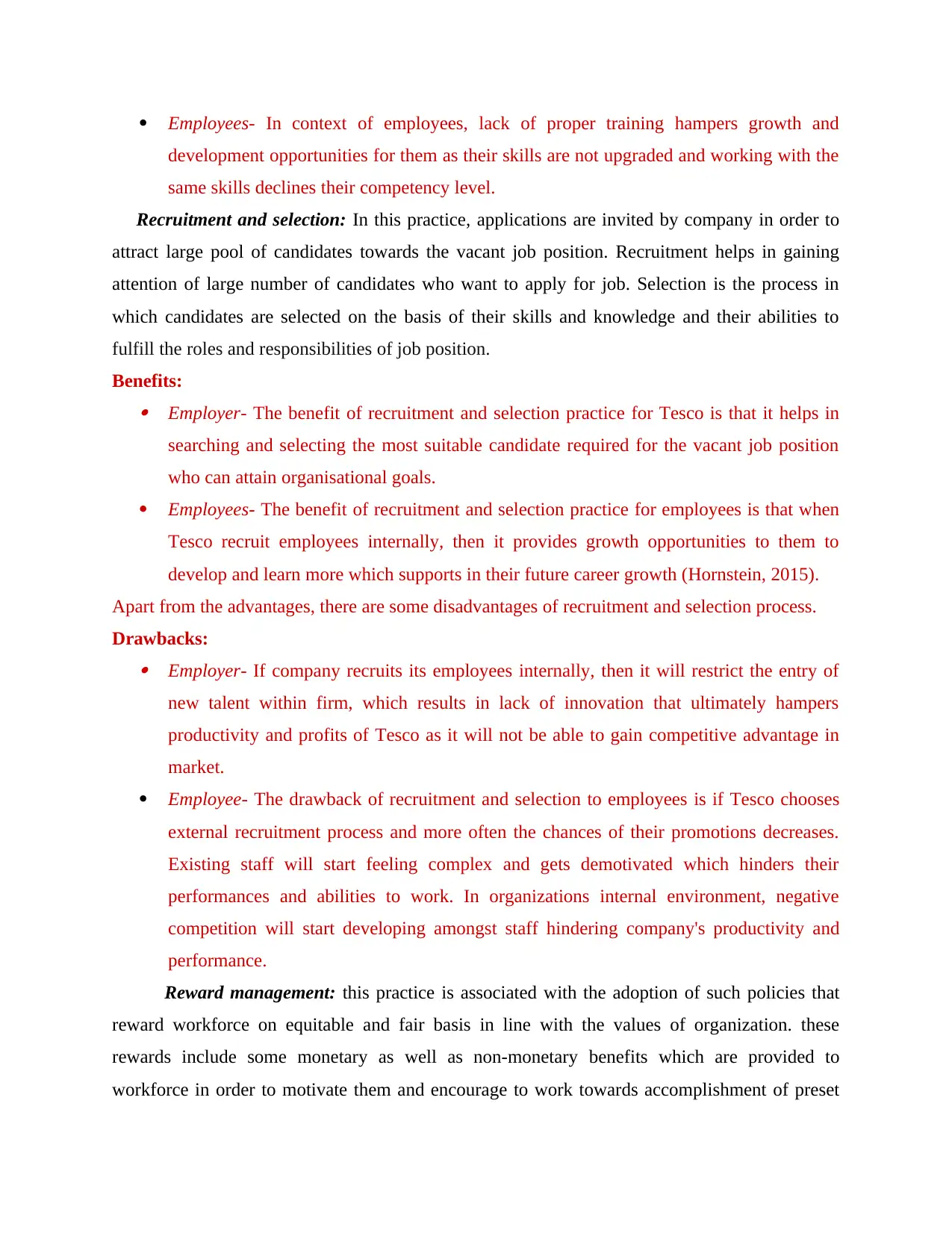
Employees- In context of employees, lack of proper training hampers growth and
development opportunities for them as their skills are not upgraded and working with the
same skills declines their competency level.
Recruitment and selection: In this practice, applications are invited by company in order to
attract large pool of candidates towards the vacant job position. Recruitment helps in gaining
attention of large number of candidates who want to apply for job. Selection is the process in
which candidates are selected on the basis of their skills and knowledge and their abilities to
fulfill the roles and responsibilities of job position.
Benefits: Employer- The benefit of recruitment and selection practice for Tesco is that it helps in
searching and selecting the most suitable candidate required for the vacant job position
who can attain organisational goals.
Employees- The benefit of recruitment and selection practice for employees is that when
Tesco recruit employees internally, then it provides growth opportunities to them to
develop and learn more which supports in their future career growth (Hornstein, 2015).
Apart from the advantages, there are some disadvantages of recruitment and selection process.
Drawbacks: Employer- If company recruits its employees internally, then it will restrict the entry of
new talent within firm, which results in lack of innovation that ultimately hampers
productivity and profits of Tesco as it will not be able to gain competitive advantage in
market.
Employee- The drawback of recruitment and selection to employees is if Tesco chooses
external recruitment process and more often the chances of their promotions decreases.
Existing staff will start feeling complex and gets demotivated which hinders their
performances and abilities to work. In organizations internal environment, negative
competition will start developing amongst staff hindering company's productivity and
performance.
Reward management: this practice is associated with the adoption of such policies that
reward workforce on equitable and fair basis in line with the values of organization. these
rewards include some monetary as well as non-monetary benefits which are provided to
workforce in order to motivate them and encourage to work towards accomplishment of preset
development opportunities for them as their skills are not upgraded and working with the
same skills declines their competency level.
Recruitment and selection: In this practice, applications are invited by company in order to
attract large pool of candidates towards the vacant job position. Recruitment helps in gaining
attention of large number of candidates who want to apply for job. Selection is the process in
which candidates are selected on the basis of their skills and knowledge and their abilities to
fulfill the roles and responsibilities of job position.
Benefits: Employer- The benefit of recruitment and selection practice for Tesco is that it helps in
searching and selecting the most suitable candidate required for the vacant job position
who can attain organisational goals.
Employees- The benefit of recruitment and selection practice for employees is that when
Tesco recruit employees internally, then it provides growth opportunities to them to
develop and learn more which supports in their future career growth (Hornstein, 2015).
Apart from the advantages, there are some disadvantages of recruitment and selection process.
Drawbacks: Employer- If company recruits its employees internally, then it will restrict the entry of
new talent within firm, which results in lack of innovation that ultimately hampers
productivity and profits of Tesco as it will not be able to gain competitive advantage in
market.
Employee- The drawback of recruitment and selection to employees is if Tesco chooses
external recruitment process and more often the chances of their promotions decreases.
Existing staff will start feeling complex and gets demotivated which hinders their
performances and abilities to work. In organizations internal environment, negative
competition will start developing amongst staff hindering company's productivity and
performance.
Reward management: this practice is associated with the adoption of such policies that
reward workforce on equitable and fair basis in line with the values of organization. these
rewards include some monetary as well as non-monetary benefits which are provided to
workforce in order to motivate them and encourage to work towards accomplishment of preset
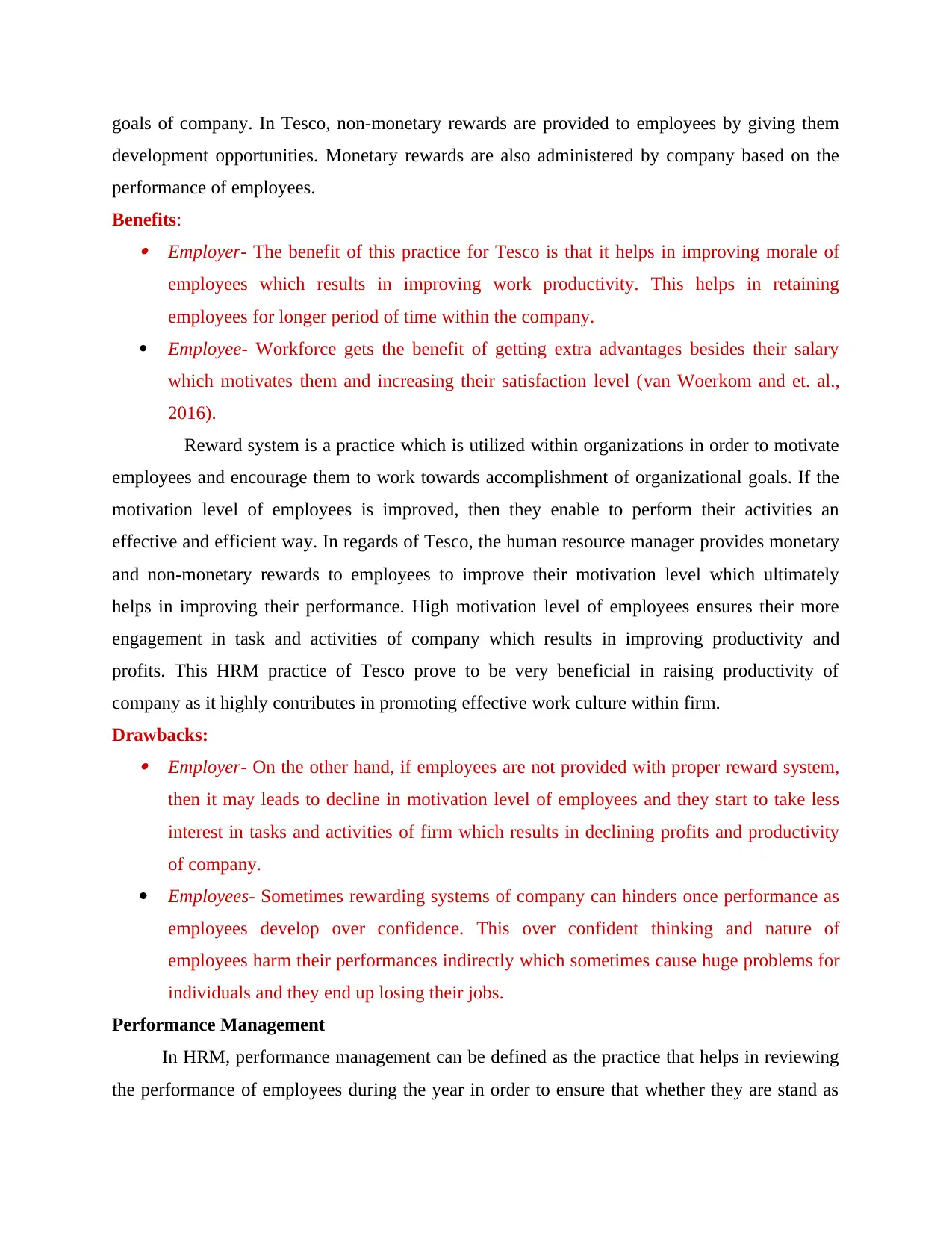
goals of company. In Tesco, non-monetary rewards are provided to employees by giving them
development opportunities. Monetary rewards are also administered by company based on the
performance of employees.
Benefits: Employer- The benefit of this practice for Tesco is that it helps in improving morale of
employees which results in improving work productivity. This helps in retaining
employees for longer period of time within the company.
Employee- Workforce gets the benefit of getting extra advantages besides their salary
which motivates them and increasing their satisfaction level (van Woerkom and et. al.,
2016).
Reward system is a practice which is utilized within organizations in order to motivate
employees and encourage them to work towards accomplishment of organizational goals. If the
motivation level of employees is improved, then they enable to perform their activities an
effective and efficient way. In regards of Tesco, the human resource manager provides monetary
and non-monetary rewards to employees to improve their motivation level which ultimately
helps in improving their performance. High motivation level of employees ensures their more
engagement in task and activities of company which results in improving productivity and
profits. This HRM practice of Tesco prove to be very beneficial in raising productivity of
company as it highly contributes in promoting effective work culture within firm.
Drawbacks: Employer- On the other hand, if employees are not provided with proper reward system,
then it may leads to decline in motivation level of employees and they start to take less
interest in tasks and activities of firm which results in declining profits and productivity
of company.
Employees- Sometimes rewarding systems of company can hinders once performance as
employees develop over confidence. This over confident thinking and nature of
employees harm their performances indirectly which sometimes cause huge problems for
individuals and they end up losing their jobs.
Performance Management
In HRM, performance management can be defined as the practice that helps in reviewing
the performance of employees during the year in order to ensure that whether they are stand as
development opportunities. Monetary rewards are also administered by company based on the
performance of employees.
Benefits: Employer- The benefit of this practice for Tesco is that it helps in improving morale of
employees which results in improving work productivity. This helps in retaining
employees for longer period of time within the company.
Employee- Workforce gets the benefit of getting extra advantages besides their salary
which motivates them and increasing their satisfaction level (van Woerkom and et. al.,
2016).
Reward system is a practice which is utilized within organizations in order to motivate
employees and encourage them to work towards accomplishment of organizational goals. If the
motivation level of employees is improved, then they enable to perform their activities an
effective and efficient way. In regards of Tesco, the human resource manager provides monetary
and non-monetary rewards to employees to improve their motivation level which ultimately
helps in improving their performance. High motivation level of employees ensures their more
engagement in task and activities of company which results in improving productivity and
profits. This HRM practice of Tesco prove to be very beneficial in raising productivity of
company as it highly contributes in promoting effective work culture within firm.
Drawbacks: Employer- On the other hand, if employees are not provided with proper reward system,
then it may leads to decline in motivation level of employees and they start to take less
interest in tasks and activities of firm which results in declining profits and productivity
of company.
Employees- Sometimes rewarding systems of company can hinders once performance as
employees develop over confidence. This over confident thinking and nature of
employees harm their performances indirectly which sometimes cause huge problems for
individuals and they end up losing their jobs.
Performance Management
In HRM, performance management can be defined as the practice that helps in reviewing
the performance of employees during the year in order to ensure that whether they are stand as
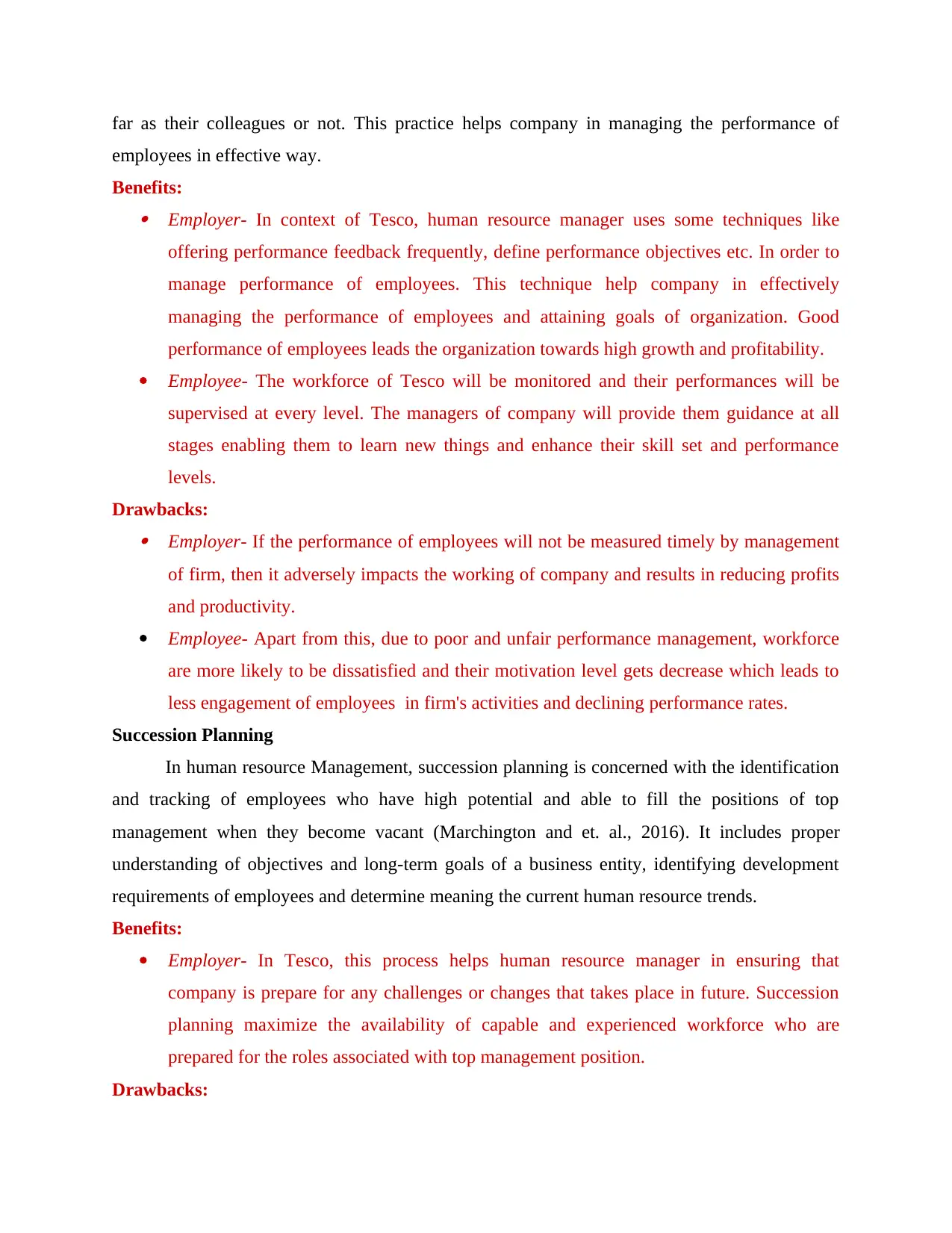
far as their colleagues or not. This practice helps company in managing the performance of
employees in effective way.
Benefits: Employer- In context of Tesco, human resource manager uses some techniques like
offering performance feedback frequently, define performance objectives etc. In order to
manage performance of employees. This technique help company in effectively
managing the performance of employees and attaining goals of organization. Good
performance of employees leads the organization towards high growth and profitability.
Employee- The workforce of Tesco will be monitored and their performances will be
supervised at every level. The managers of company will provide them guidance at all
stages enabling them to learn new things and enhance their skill set and performance
levels.
Drawbacks: Employer- If the performance of employees will not be measured timely by management
of firm, then it adversely impacts the working of company and results in reducing profits
and productivity.
Employee- Apart from this, due to poor and unfair performance management, workforce
are more likely to be dissatisfied and their motivation level gets decrease which leads to
less engagement of employees in firm's activities and declining performance rates.
Succession Planning
In human resource Management, succession planning is concerned with the identification
and tracking of employees who have high potential and able to fill the positions of top
management when they become vacant (Marchington and et. al., 2016). It includes proper
understanding of objectives and long-term goals of a business entity, identifying development
requirements of employees and determine meaning the current human resource trends.
Benefits:
Employer- In Tesco, this process helps human resource manager in ensuring that
company is prepare for any challenges or changes that takes place in future. Succession
planning maximize the availability of capable and experienced workforce who are
prepared for the roles associated with top management position.
Drawbacks:
employees in effective way.
Benefits: Employer- In context of Tesco, human resource manager uses some techniques like
offering performance feedback frequently, define performance objectives etc. In order to
manage performance of employees. This technique help company in effectively
managing the performance of employees and attaining goals of organization. Good
performance of employees leads the organization towards high growth and profitability.
Employee- The workforce of Tesco will be monitored and their performances will be
supervised at every level. The managers of company will provide them guidance at all
stages enabling them to learn new things and enhance their skill set and performance
levels.
Drawbacks: Employer- If the performance of employees will not be measured timely by management
of firm, then it adversely impacts the working of company and results in reducing profits
and productivity.
Employee- Apart from this, due to poor and unfair performance management, workforce
are more likely to be dissatisfied and their motivation level gets decrease which leads to
less engagement of employees in firm's activities and declining performance rates.
Succession Planning
In human resource Management, succession planning is concerned with the identification
and tracking of employees who have high potential and able to fill the positions of top
management when they become vacant (Marchington and et. al., 2016). It includes proper
understanding of objectives and long-term goals of a business entity, identifying development
requirements of employees and determine meaning the current human resource trends.
Benefits:
Employer- In Tesco, this process helps human resource manager in ensuring that
company is prepare for any challenges or changes that takes place in future. Succession
planning maximize the availability of capable and experienced workforce who are
prepared for the roles associated with top management position.
Drawbacks:
Paraphrase This Document
Need a fresh take? Get an instant paraphrase of this document with our AI Paraphraser
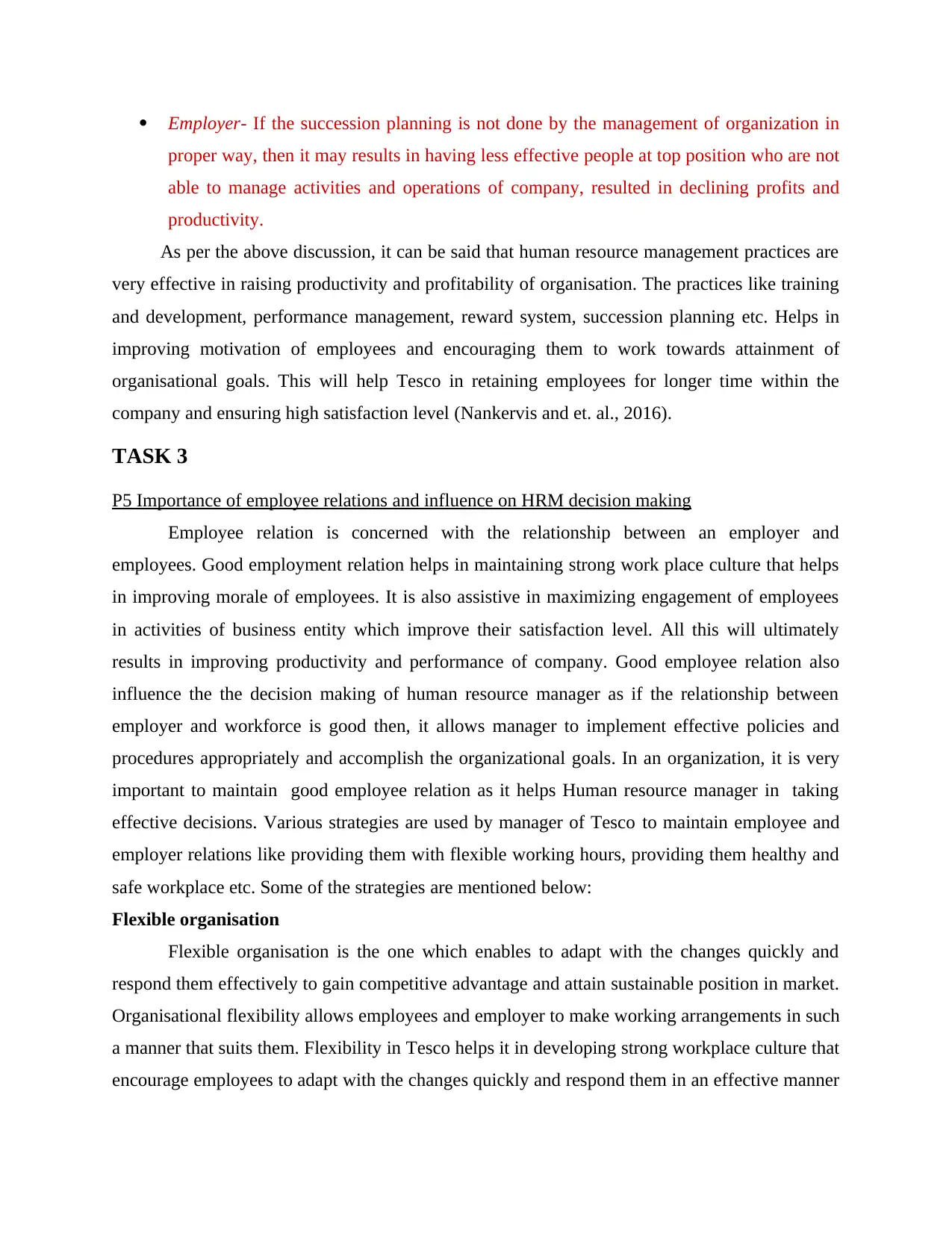
Employer- If the succession planning is not done by the management of organization in
proper way, then it may results in having less effective people at top position who are not
able to manage activities and operations of company, resulted in declining profits and
productivity.
As per the above discussion, it can be said that human resource management practices are
very effective in raising productivity and profitability of organisation. The practices like training
and development, performance management, reward system, succession planning etc. Helps in
improving motivation of employees and encouraging them to work towards attainment of
organisational goals. This will help Tesco in retaining employees for longer time within the
company and ensuring high satisfaction level (Nankervis and et. al., 2016).
TASK 3
P5 Importance of employee relations and influence on HRM decision making
Employee relation is concerned with the relationship between an employer and
employees. Good employment relation helps in maintaining strong work place culture that helps
in improving morale of employees. It is also assistive in maximizing engagement of employees
in activities of business entity which improve their satisfaction level. All this will ultimately
results in improving productivity and performance of company. Good employee relation also
influence the the decision making of human resource manager as if the relationship between
employer and workforce is good then, it allows manager to implement effective policies and
procedures appropriately and accomplish the organizational goals. In an organization, it is very
important to maintain good employee relation as it helps Human resource manager in taking
effective decisions. Various strategies are used by manager of Tesco to maintain employee and
employer relations like providing them with flexible working hours, providing them healthy and
safe workplace etc. Some of the strategies are mentioned below:
Flexible organisation
Flexible organisation is the one which enables to adapt with the changes quickly and
respond them effectively to gain competitive advantage and attain sustainable position in market.
Organisational flexibility allows employees and employer to make working arrangements in such
a manner that suits them. Flexibility in Tesco helps it in developing strong workplace culture that
encourage employees to adapt with the changes quickly and respond them in an effective manner
proper way, then it may results in having less effective people at top position who are not
able to manage activities and operations of company, resulted in declining profits and
productivity.
As per the above discussion, it can be said that human resource management practices are
very effective in raising productivity and profitability of organisation. The practices like training
and development, performance management, reward system, succession planning etc. Helps in
improving motivation of employees and encouraging them to work towards attainment of
organisational goals. This will help Tesco in retaining employees for longer time within the
company and ensuring high satisfaction level (Nankervis and et. al., 2016).
TASK 3
P5 Importance of employee relations and influence on HRM decision making
Employee relation is concerned with the relationship between an employer and
employees. Good employment relation helps in maintaining strong work place culture that helps
in improving morale of employees. It is also assistive in maximizing engagement of employees
in activities of business entity which improve their satisfaction level. All this will ultimately
results in improving productivity and performance of company. Good employee relation also
influence the the decision making of human resource manager as if the relationship between
employer and workforce is good then, it allows manager to implement effective policies and
procedures appropriately and accomplish the organizational goals. In an organization, it is very
important to maintain good employee relation as it helps Human resource manager in taking
effective decisions. Various strategies are used by manager of Tesco to maintain employee and
employer relations like providing them with flexible working hours, providing them healthy and
safe workplace etc. Some of the strategies are mentioned below:
Flexible organisation
Flexible organisation is the one which enables to adapt with the changes quickly and
respond them effectively to gain competitive advantage and attain sustainable position in market.
Organisational flexibility allows employees and employer to make working arrangements in such
a manner that suits them. Flexibility in Tesco helps it in developing strong workplace culture that
encourage employees to adapt with the changes quickly and respond them in an effective manner
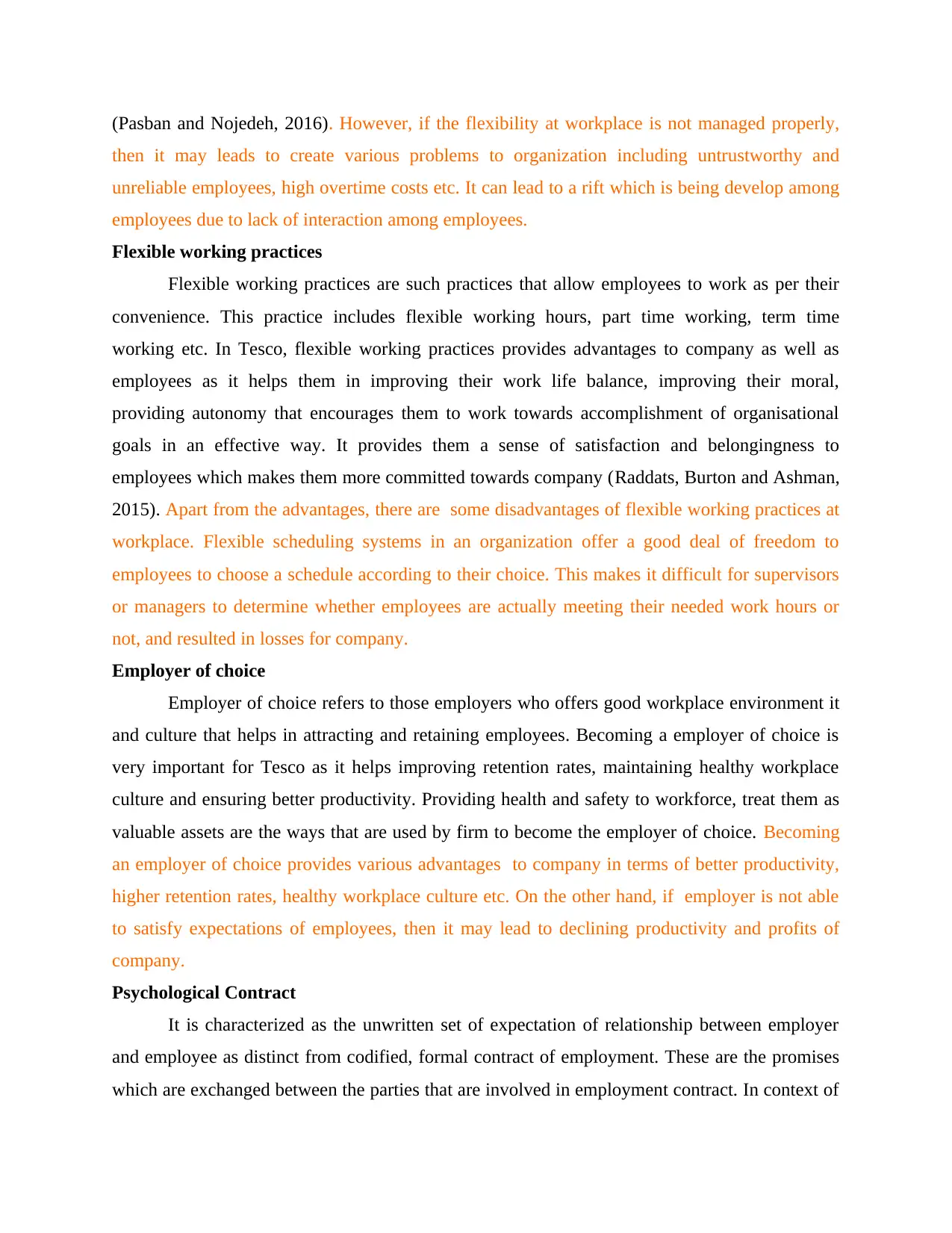
(Pasban and Nojedeh, 2016). However, if the flexibility at workplace is not managed properly,
then it may leads to create various problems to organization including untrustworthy and
unreliable employees, high overtime costs etc. It can lead to a rift which is being develop among
employees due to lack of interaction among employees.
Flexible working practices
Flexible working practices are such practices that allow employees to work as per their
convenience. This practice includes flexible working hours, part time working, term time
working etc. In Tesco, flexible working practices provides advantages to company as well as
employees as it helps them in improving their work life balance, improving their moral,
providing autonomy that encourages them to work towards accomplishment of organisational
goals in an effective way. It provides them a sense of satisfaction and belongingness to
employees which makes them more committed towards company (Raddats, Burton and Ashman,
2015). Apart from the advantages, there are some disadvantages of flexible working practices at
workplace. Flexible scheduling systems in an organization offer a good deal of freedom to
employees to choose a schedule according to their choice. This makes it difficult for supervisors
or managers to determine whether employees are actually meeting their needed work hours or
not, and resulted in losses for company.
Employer of choice
Employer of choice refers to those employers who offers good workplace environment it
and culture that helps in attracting and retaining employees. Becoming a employer of choice is
very important for Tesco as it helps improving retention rates, maintaining healthy workplace
culture and ensuring better productivity. Providing health and safety to workforce, treat them as
valuable assets are the ways that are used by firm to become the employer of choice. Becoming
an employer of choice provides various advantages to company in terms of better productivity,
higher retention rates, healthy workplace culture etc. On the other hand, if employer is not able
to satisfy expectations of employees, then it may lead to declining productivity and profits of
company.
Psychological Contract
It is characterized as the unwritten set of expectation of relationship between employer
and employee as distinct from codified, formal contract of employment. These are the promises
which are exchanged between the parties that are involved in employment contract. In context of
then it may leads to create various problems to organization including untrustworthy and
unreliable employees, high overtime costs etc. It can lead to a rift which is being develop among
employees due to lack of interaction among employees.
Flexible working practices
Flexible working practices are such practices that allow employees to work as per their
convenience. This practice includes flexible working hours, part time working, term time
working etc. In Tesco, flexible working practices provides advantages to company as well as
employees as it helps them in improving their work life balance, improving their moral,
providing autonomy that encourages them to work towards accomplishment of organisational
goals in an effective way. It provides them a sense of satisfaction and belongingness to
employees which makes them more committed towards company (Raddats, Burton and Ashman,
2015). Apart from the advantages, there are some disadvantages of flexible working practices at
workplace. Flexible scheduling systems in an organization offer a good deal of freedom to
employees to choose a schedule according to their choice. This makes it difficult for supervisors
or managers to determine whether employees are actually meeting their needed work hours or
not, and resulted in losses for company.
Employer of choice
Employer of choice refers to those employers who offers good workplace environment it
and culture that helps in attracting and retaining employees. Becoming a employer of choice is
very important for Tesco as it helps improving retention rates, maintaining healthy workplace
culture and ensuring better productivity. Providing health and safety to workforce, treat them as
valuable assets are the ways that are used by firm to become the employer of choice. Becoming
an employer of choice provides various advantages to company in terms of better productivity,
higher retention rates, healthy workplace culture etc. On the other hand, if employer is not able
to satisfy expectations of employees, then it may lead to declining productivity and profits of
company.
Psychological Contract
It is characterized as the unwritten set of expectation of relationship between employer
and employee as distinct from codified, formal contract of employment. These are the promises
which are exchanged between the parties that are involved in employment contract. In context of
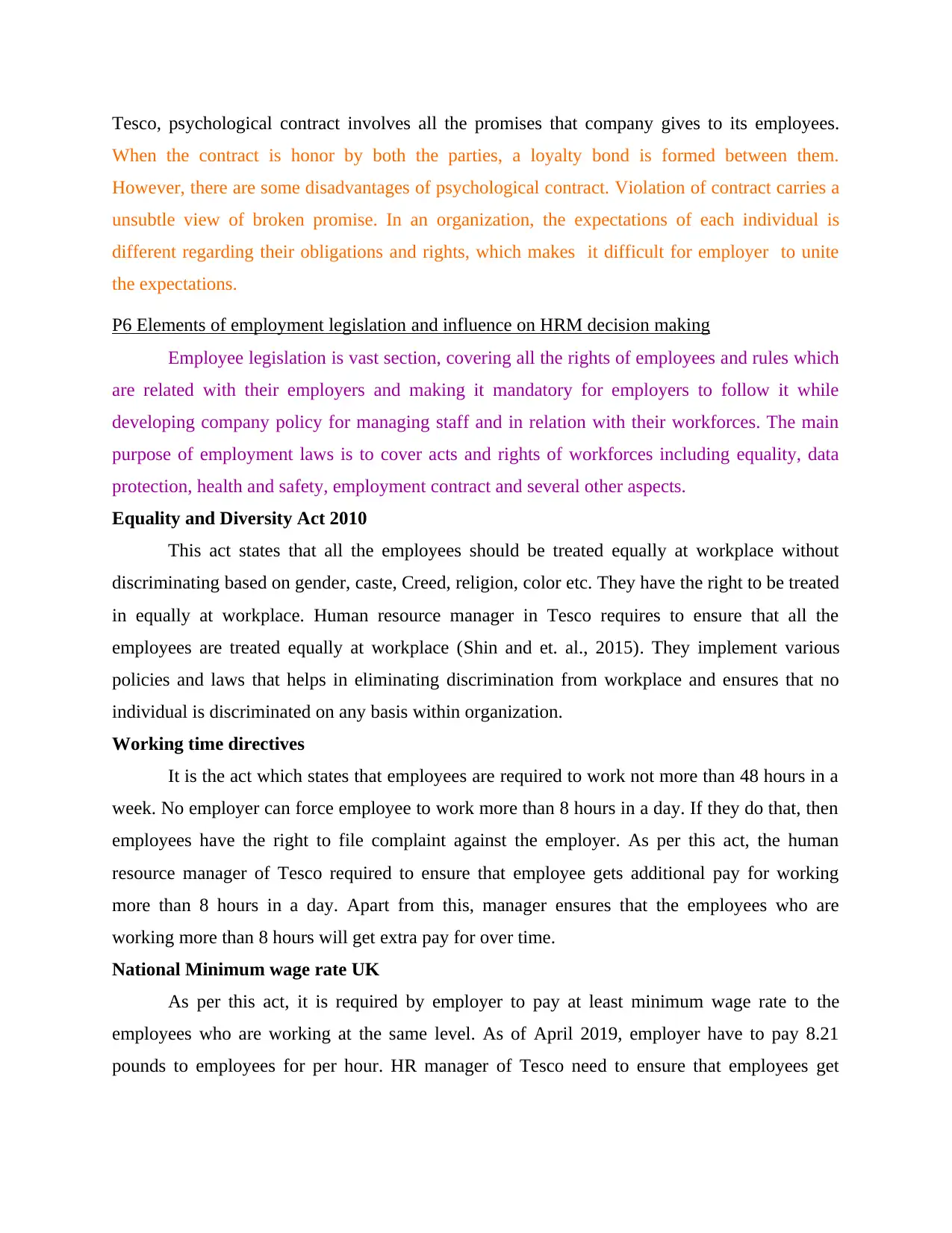
Tesco, psychological contract involves all the promises that company gives to its employees.
When the contract is honor by both the parties, a loyalty bond is formed between them.
However, there are some disadvantages of psychological contract. Violation of contract carries a
unsubtle view of broken promise. In an organization, the expectations of each individual is
different regarding their obligations and rights, which makes it difficult for employer to unite
the expectations.
P6 Elements of employment legislation and influence on HRM decision making
Employee legislation is vast section, covering all the rights of employees and rules which
are related with their employers and making it mandatory for employers to follow it while
developing company policy for managing staff and in relation with their workforces. The main
purpose of employment laws is to cover acts and rights of workforces including equality, data
protection, health and safety, employment contract and several other aspects.
Equality and Diversity Act 2010
This act states that all the employees should be treated equally at workplace without
discriminating based on gender, caste, Creed, religion, color etc. They have the right to be treated
in equally at workplace. Human resource manager in Tesco requires to ensure that all the
employees are treated equally at workplace (Shin and et. al., 2015). They implement various
policies and laws that helps in eliminating discrimination from workplace and ensures that no
individual is discriminated on any basis within organization.
Working time directives
It is the act which states that employees are required to work not more than 48 hours in a
week. No employer can force employee to work more than 8 hours in a day. If they do that, then
employees have the right to file complaint against the employer. As per this act, the human
resource manager of Tesco required to ensure that employee gets additional pay for working
more than 8 hours in a day. Apart from this, manager ensures that the employees who are
working more than 8 hours will get extra pay for over time.
National Minimum wage rate UK
As per this act, it is required by employer to pay at least minimum wage rate to the
employees who are working at the same level. As of April 2019, employer have to pay 8.21
pounds to employees for per hour. HR manager of Tesco need to ensure that employees get
When the contract is honor by both the parties, a loyalty bond is formed between them.
However, there are some disadvantages of psychological contract. Violation of contract carries a
unsubtle view of broken promise. In an organization, the expectations of each individual is
different regarding their obligations and rights, which makes it difficult for employer to unite
the expectations.
P6 Elements of employment legislation and influence on HRM decision making
Employee legislation is vast section, covering all the rights of employees and rules which
are related with their employers and making it mandatory for employers to follow it while
developing company policy for managing staff and in relation with their workforces. The main
purpose of employment laws is to cover acts and rights of workforces including equality, data
protection, health and safety, employment contract and several other aspects.
Equality and Diversity Act 2010
This act states that all the employees should be treated equally at workplace without
discriminating based on gender, caste, Creed, religion, color etc. They have the right to be treated
in equally at workplace. Human resource manager in Tesco requires to ensure that all the
employees are treated equally at workplace (Shin and et. al., 2015). They implement various
policies and laws that helps in eliminating discrimination from workplace and ensures that no
individual is discriminated on any basis within organization.
Working time directives
It is the act which states that employees are required to work not more than 48 hours in a
week. No employer can force employee to work more than 8 hours in a day. If they do that, then
employees have the right to file complaint against the employer. As per this act, the human
resource manager of Tesco required to ensure that employee gets additional pay for working
more than 8 hours in a day. Apart from this, manager ensures that the employees who are
working more than 8 hours will get extra pay for over time.
National Minimum wage rate UK
As per this act, it is required by employer to pay at least minimum wage rate to the
employees who are working at the same level. As of April 2019, employer have to pay 8.21
pounds to employees for per hour. HR manager of Tesco need to ensure that employees get
Secure Best Marks with AI Grader
Need help grading? Try our AI Grader for instant feedback on your assignments.
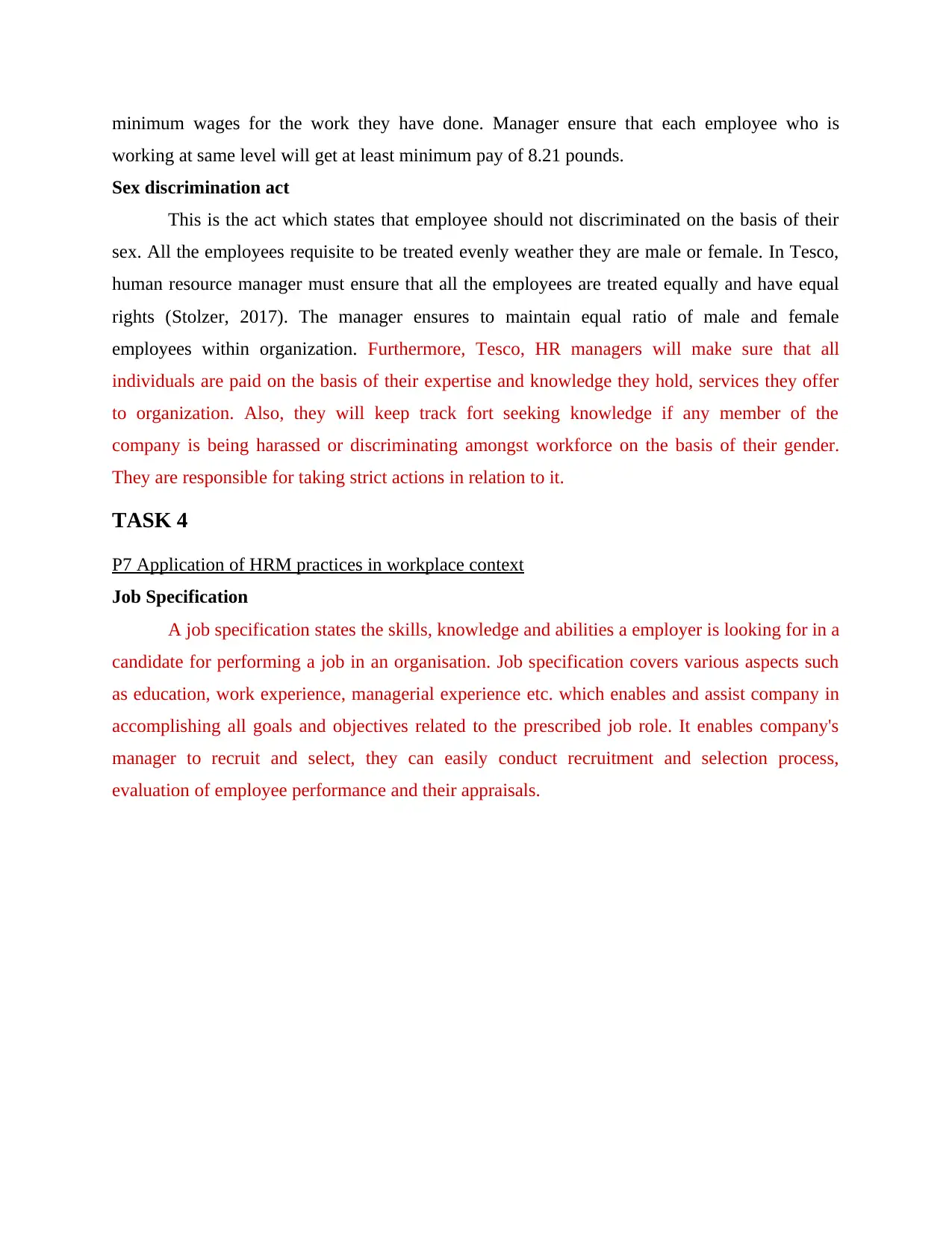
minimum wages for the work they have done. Manager ensure that each employee who is
working at same level will get at least minimum pay of 8.21 pounds.
Sex discrimination act
This is the act which states that employee should not discriminated on the basis of their
sex. All the employees requisite to be treated evenly weather they are male or female. In Tesco,
human resource manager must ensure that all the employees are treated equally and have equal
rights (Stolzer, 2017). The manager ensures to maintain equal ratio of male and female
employees within organization. Furthermore, Tesco, HR managers will make sure that all
individuals are paid on the basis of their expertise and knowledge they hold, services they offer
to organization. Also, they will keep track fort seeking knowledge if any member of the
company is being harassed or discriminating amongst workforce on the basis of their gender.
They are responsible for taking strict actions in relation to it.
TASK 4
P7 Application of HRM practices in workplace context
Job Specification
A job specification states the skills, knowledge and abilities a employer is looking for in a
candidate for performing a job in an organisation. Job specification covers various aspects such
as education, work experience, managerial experience etc. which enables and assist company in
accomplishing all goals and objectives related to the prescribed job role. It enables company's
manager to recruit and select, they can easily conduct recruitment and selection process,
evaluation of employee performance and their appraisals.
working at same level will get at least minimum pay of 8.21 pounds.
Sex discrimination act
This is the act which states that employee should not discriminated on the basis of their
sex. All the employees requisite to be treated evenly weather they are male or female. In Tesco,
human resource manager must ensure that all the employees are treated equally and have equal
rights (Stolzer, 2017). The manager ensures to maintain equal ratio of male and female
employees within organization. Furthermore, Tesco, HR managers will make sure that all
individuals are paid on the basis of their expertise and knowledge they hold, services they offer
to organization. Also, they will keep track fort seeking knowledge if any member of the
company is being harassed or discriminating amongst workforce on the basis of their gender.
They are responsible for taking strict actions in relation to it.
TASK 4
P7 Application of HRM practices in workplace context
Job Specification
A job specification states the skills, knowledge and abilities a employer is looking for in a
candidate for performing a job in an organisation. Job specification covers various aspects such
as education, work experience, managerial experience etc. which enables and assist company in
accomplishing all goals and objectives related to the prescribed job role. It enables company's
manager to recruit and select, they can easily conduct recruitment and selection process,
evaluation of employee performance and their appraisals.
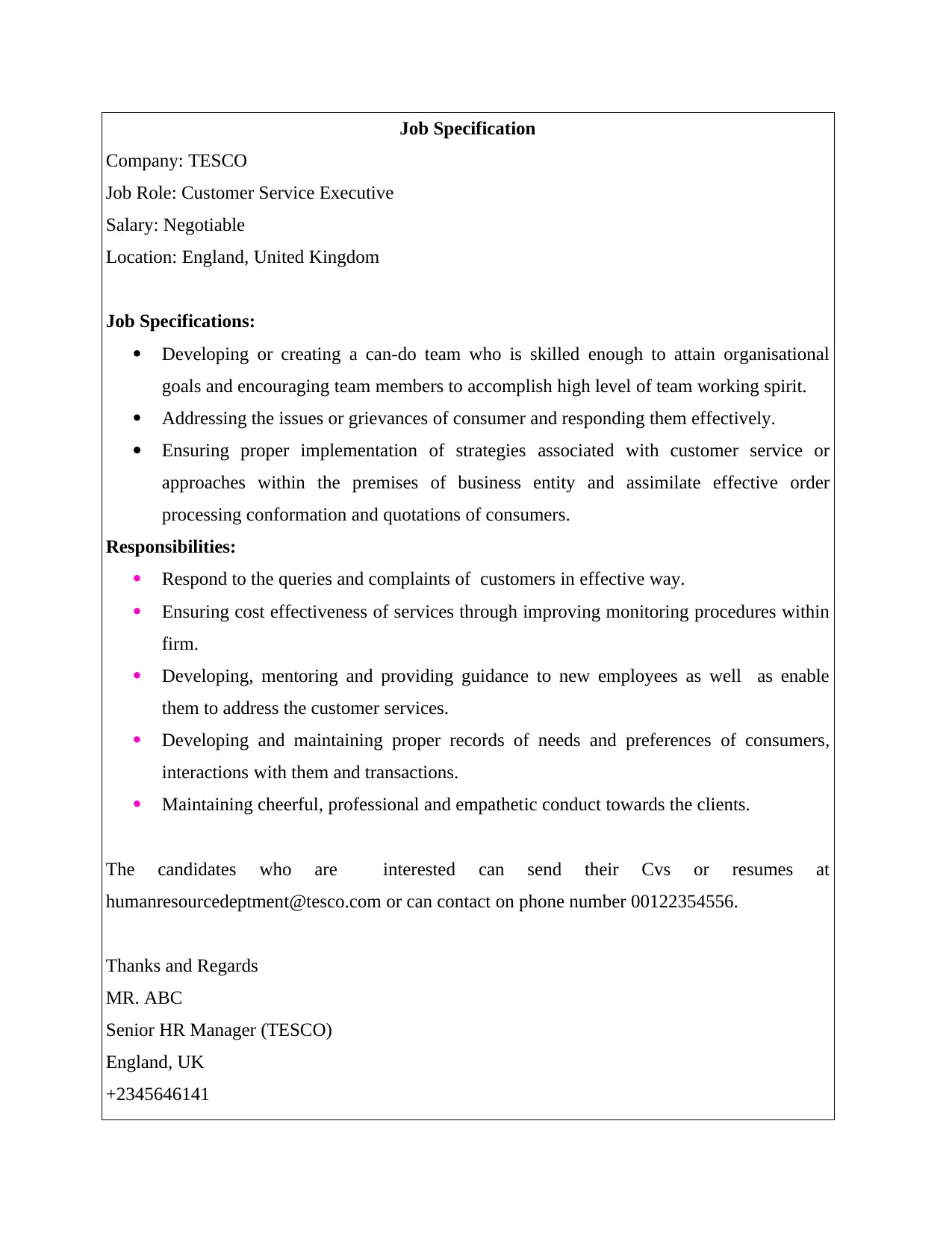
Job Specification
Company: TESCO
Job Role: Customer Service Executive
Salary: Negotiable
Location: England, United Kingdom
Job Specifications:
Developing or creating a can-do team who is skilled enough to attain organisational
goals and encouraging team members to accomplish high level of team working spirit.
Addressing the issues or grievances of consumer and responding them effectively.
Ensuring proper implementation of strategies associated with customer service or
approaches within the premises of business entity and assimilate effective order
processing conformation and quotations of consumers.
Responsibilities:
Respond to the queries and complaints of customers in effective way.
Ensuring cost effectiveness of services through improving monitoring procedures within
firm.
Developing, mentoring and providing guidance to new employees as well as enable
them to address the customer services.
Developing and maintaining proper records of needs and preferences of consumers,
interactions with them and transactions.
Maintaining cheerful, professional and empathetic conduct towards the clients.
The candidates who are interested can send their Cvs or resumes at
humanresourcedeptment@tesco.com or can contact on phone number 00122354556.
Thanks and Regards
MR. ABC
Senior HR Manager (TESCO)
England, UK
+2345646141
Company: TESCO
Job Role: Customer Service Executive
Salary: Negotiable
Location: England, United Kingdom
Job Specifications:
Developing or creating a can-do team who is skilled enough to attain organisational
goals and encouraging team members to accomplish high level of team working spirit.
Addressing the issues or grievances of consumer and responding them effectively.
Ensuring proper implementation of strategies associated with customer service or
approaches within the premises of business entity and assimilate effective order
processing conformation and quotations of consumers.
Responsibilities:
Respond to the queries and complaints of customers in effective way.
Ensuring cost effectiveness of services through improving monitoring procedures within
firm.
Developing, mentoring and providing guidance to new employees as well as enable
them to address the customer services.
Developing and maintaining proper records of needs and preferences of consumers,
interactions with them and transactions.
Maintaining cheerful, professional and empathetic conduct towards the clients.
The candidates who are interested can send their Cvs or resumes at
humanresourcedeptment@tesco.com or can contact on phone number 00122354556.
Thanks and Regards
MR. ABC
Senior HR Manager (TESCO)
England, UK
+2345646141
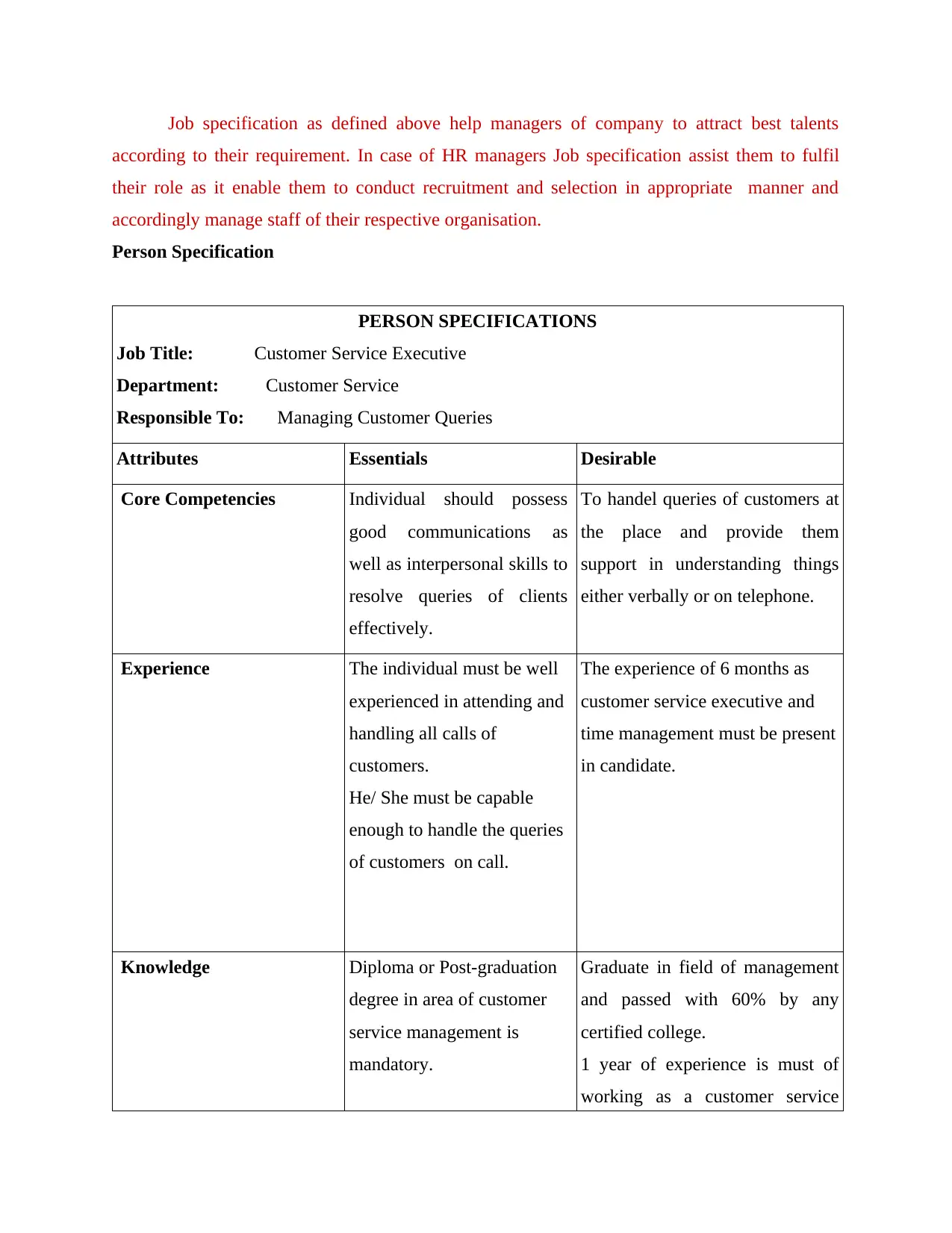
Job specification as defined above help managers of company to attract best talents
according to their requirement. In case of HR managers Job specification assist them to fulfil
their role as it enable them to conduct recruitment and selection in appropriate manner and
accordingly manage staff of their respective organisation.
Person Specification
PERSON SPECIFICATIONS
Job Title: Customer Service Executive
Department: Customer Service
Responsible To: Managing Customer Queries
Attributes Essentials Desirable
Core Competencies Individual should possess
good communications as
well as interpersonal skills to
resolve queries of clients
effectively.
To handel queries of customers at
the place and provide them
support in understanding things
either verbally or on telephone.
Experience The individual must be well
experienced in attending and
handling all calls of
customers.
He/ She must be capable
enough to handle the queries
of customers on call.
The experience of 6 months as
customer service executive and
time management must be present
in candidate.
Knowledge Diploma or Post-graduation
degree in area of customer
service management is
mandatory.
Graduate in field of management
and passed with 60% by any
certified college.
1 year of experience is must of
working as a customer service
according to their requirement. In case of HR managers Job specification assist them to fulfil
their role as it enable them to conduct recruitment and selection in appropriate manner and
accordingly manage staff of their respective organisation.
Person Specification
PERSON SPECIFICATIONS
Job Title: Customer Service Executive
Department: Customer Service
Responsible To: Managing Customer Queries
Attributes Essentials Desirable
Core Competencies Individual should possess
good communications as
well as interpersonal skills to
resolve queries of clients
effectively.
To handel queries of customers at
the place and provide them
support in understanding things
either verbally or on telephone.
Experience The individual must be well
experienced in attending and
handling all calls of
customers.
He/ She must be capable
enough to handle the queries
of customers on call.
The experience of 6 months as
customer service executive and
time management must be present
in candidate.
Knowledge Diploma or Post-graduation
degree in area of customer
service management is
mandatory.
Graduate in field of management
and passed with 60% by any
certified college.
1 year of experience is must of
working as a customer service
Paraphrase This Document
Need a fresh take? Get an instant paraphrase of this document with our AI Paraphraser
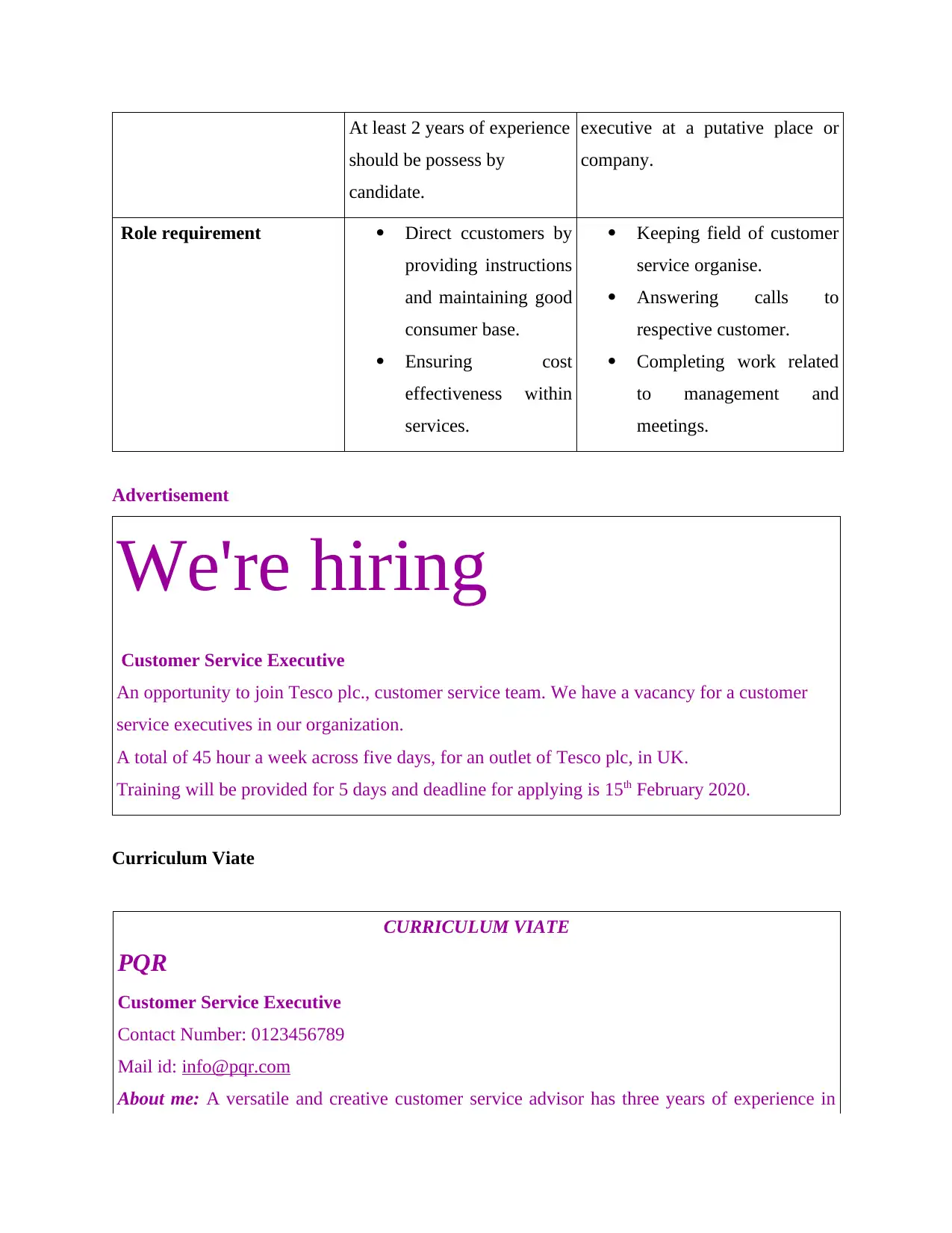
At least 2 years of experience
should be possess by
candidate.
executive at a putative place or
company.
Role requirement Direct ccustomers by
providing instructions
and maintaining good
consumer base.
Ensuring cost
effectiveness within
services.
Keeping field of customer
service organise.
Answering calls to
respective customer.
Completing work related
to management and
meetings.
Advertisement
We're hiring
Customer Service Executive
An opportunity to join Tesco plc., customer service team. We have a vacancy for a customer
service executives in our organization.
A total of 45 hour a week across five days, for an outlet of Tesco plc, in UK.
Training will be provided for 5 days and deadline for applying is 15th February 2020.
Curriculum Viate
CURRICULUM VIATE
PQR
Customer Service Executive
Contact Number: 0123456789
Mail id: info@pqr.com
About me: A versatile and creative customer service advisor has three years of experience in
should be possess by
candidate.
executive at a putative place or
company.
Role requirement Direct ccustomers by
providing instructions
and maintaining good
consumer base.
Ensuring cost
effectiveness within
services.
Keeping field of customer
service organise.
Answering calls to
respective customer.
Completing work related
to management and
meetings.
Advertisement
We're hiring
Customer Service Executive
An opportunity to join Tesco plc., customer service team. We have a vacancy for a customer
service executives in our organization.
A total of 45 hour a week across five days, for an outlet of Tesco plc, in UK.
Training will be provided for 5 days and deadline for applying is 15th February 2020.
Curriculum Viate
CURRICULUM VIATE
PQR
Customer Service Executive
Contact Number: 0123456789
Mail id: info@pqr.com
About me: A versatile and creative customer service advisor has three years of experience in
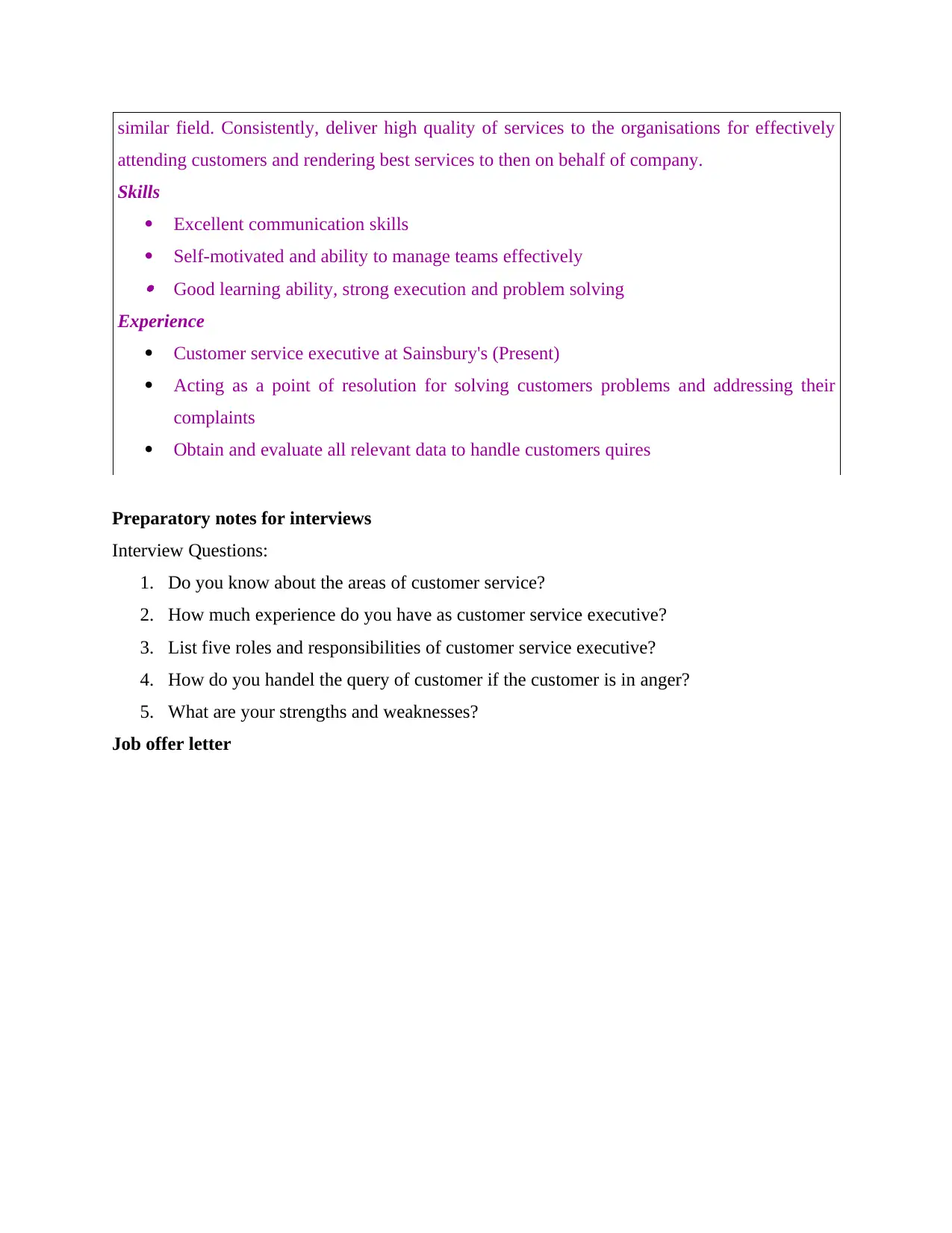
similar field. Consistently, deliver high quality of services to the organisations for effectively
attending customers and rendering best services to then on behalf of company.
Skills
Excellent communication skills
Self-motivated and ability to manage teams effectively Good learning ability, strong execution and problem solving
Experience
Customer service executive at Sainsbury's (Present)
Acting as a point of resolution for solving customers problems and addressing their
complaints
Obtain and evaluate all relevant data to handle customers quires
Preparatory notes for interviews
Interview Questions:
1. Do you know about the areas of customer service?
2. How much experience do you have as customer service executive?
3. List five roles and responsibilities of customer service executive?
4. How do you handel the query of customer if the customer is in anger?
5. What are your strengths and weaknesses?
Job offer letter
attending customers and rendering best services to then on behalf of company.
Skills
Excellent communication skills
Self-motivated and ability to manage teams effectively Good learning ability, strong execution and problem solving
Experience
Customer service executive at Sainsbury's (Present)
Acting as a point of resolution for solving customers problems and addressing their
complaints
Obtain and evaluate all relevant data to handle customers quires
Preparatory notes for interviews
Interview Questions:
1. Do you know about the areas of customer service?
2. How much experience do you have as customer service executive?
3. List five roles and responsibilities of customer service executive?
4. How do you handel the query of customer if the customer is in anger?
5. What are your strengths and weaknesses?
Job offer letter

Job Offer Letter
TESO Multinational
1211, Apex Mall Drive
England, UK
December 26, 2019
Mr. XYZ
HR representative
Old Gloucester Street, England, UK
I am glad to offer you the designation of Customer Service Executive in company. The job is
for full time in which 6 working days is conducted in a week. The initial salary provided to you
will be 25,000 pounds. You will be provided with some additional benefits such as incentives,
leaves etc. as you are a full-time employee. The key benefits and attributes of employment
offer are mentioned in the basined document.
If you accept this offer and wants to work with us, I would call you for required attachments
of your identity, qualification certificates to complete the formalities at your soonest possible
convenience. Any questions and queries regarding the policies and procedures of employment
can be asked. Please do not waver to ask or to contact me if you have any queries. Contact me
on this mobile number +0012456786412.
Sincerely,
Mr. ABC
Senior HR Manager
TESCO Multinational
In the above section several documents are prepared in order to conduct the recruitment
process for the job role of Customer Service Executive. For doing so Tesco managers has first
present the job specification in which the addressed their requirement. Then a person
specification is made which addresses the essential skills and desired skills which are required by
TESO Multinational
1211, Apex Mall Drive
England, UK
December 26, 2019
Mr. XYZ
HR representative
Old Gloucester Street, England, UK
I am glad to offer you the designation of Customer Service Executive in company. The job is
for full time in which 6 working days is conducted in a week. The initial salary provided to you
will be 25,000 pounds. You will be provided with some additional benefits such as incentives,
leaves etc. as you are a full-time employee. The key benefits and attributes of employment
offer are mentioned in the basined document.
If you accept this offer and wants to work with us, I would call you for required attachments
of your identity, qualification certificates to complete the formalities at your soonest possible
convenience. Any questions and queries regarding the policies and procedures of employment
can be asked. Please do not waver to ask or to contact me if you have any queries. Contact me
on this mobile number +0012456786412.
Sincerely,
Mr. ABC
Senior HR Manager
TESCO Multinational
In the above section several documents are prepared in order to conduct the recruitment
process for the job role of Customer Service Executive. For doing so Tesco managers has first
present the job specification in which the addressed their requirement. Then a person
specification is made which addresses the essential skills and desired skills which are required by
Secure Best Marks with AI Grader
Need help grading? Try our AI Grader for instant feedback on your assignments.
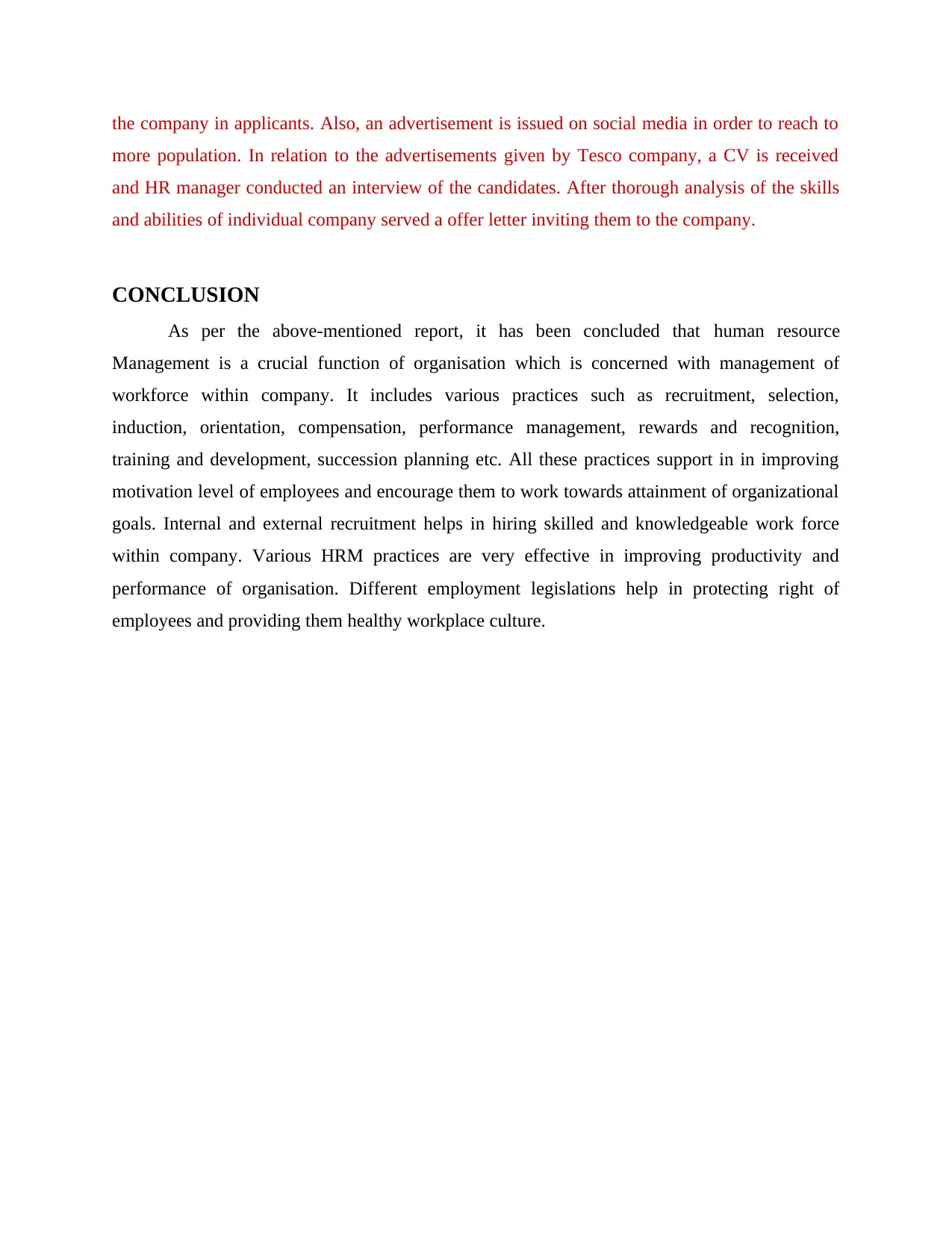
the company in applicants. Also, an advertisement is issued on social media in order to reach to
more population. In relation to the advertisements given by Tesco company, a CV is received
and HR manager conducted an interview of the candidates. After thorough analysis of the skills
and abilities of individual company served a offer letter inviting them to the company.
CONCLUSION
As per the above-mentioned report, it has been concluded that human resource
Management is a crucial function of organisation which is concerned with management of
workforce within company. It includes various practices such as recruitment, selection,
induction, orientation, compensation, performance management, rewards and recognition,
training and development, succession planning etc. All these practices support in in improving
motivation level of employees and encourage them to work towards attainment of organizational
goals. Internal and external recruitment helps in hiring skilled and knowledgeable work force
within company. Various HRM practices are very effective in improving productivity and
performance of organisation. Different employment legislations help in protecting right of
employees and providing them healthy workplace culture.
more population. In relation to the advertisements given by Tesco company, a CV is received
and HR manager conducted an interview of the candidates. After thorough analysis of the skills
and abilities of individual company served a offer letter inviting them to the company.
CONCLUSION
As per the above-mentioned report, it has been concluded that human resource
Management is a crucial function of organisation which is concerned with management of
workforce within company. It includes various practices such as recruitment, selection,
induction, orientation, compensation, performance management, rewards and recognition,
training and development, succession planning etc. All these practices support in in improving
motivation level of employees and encourage them to work towards attainment of organizational
goals. Internal and external recruitment helps in hiring skilled and knowledgeable work force
within company. Various HRM practices are very effective in improving productivity and
performance of organisation. Different employment legislations help in protecting right of
employees and providing them healthy workplace culture.
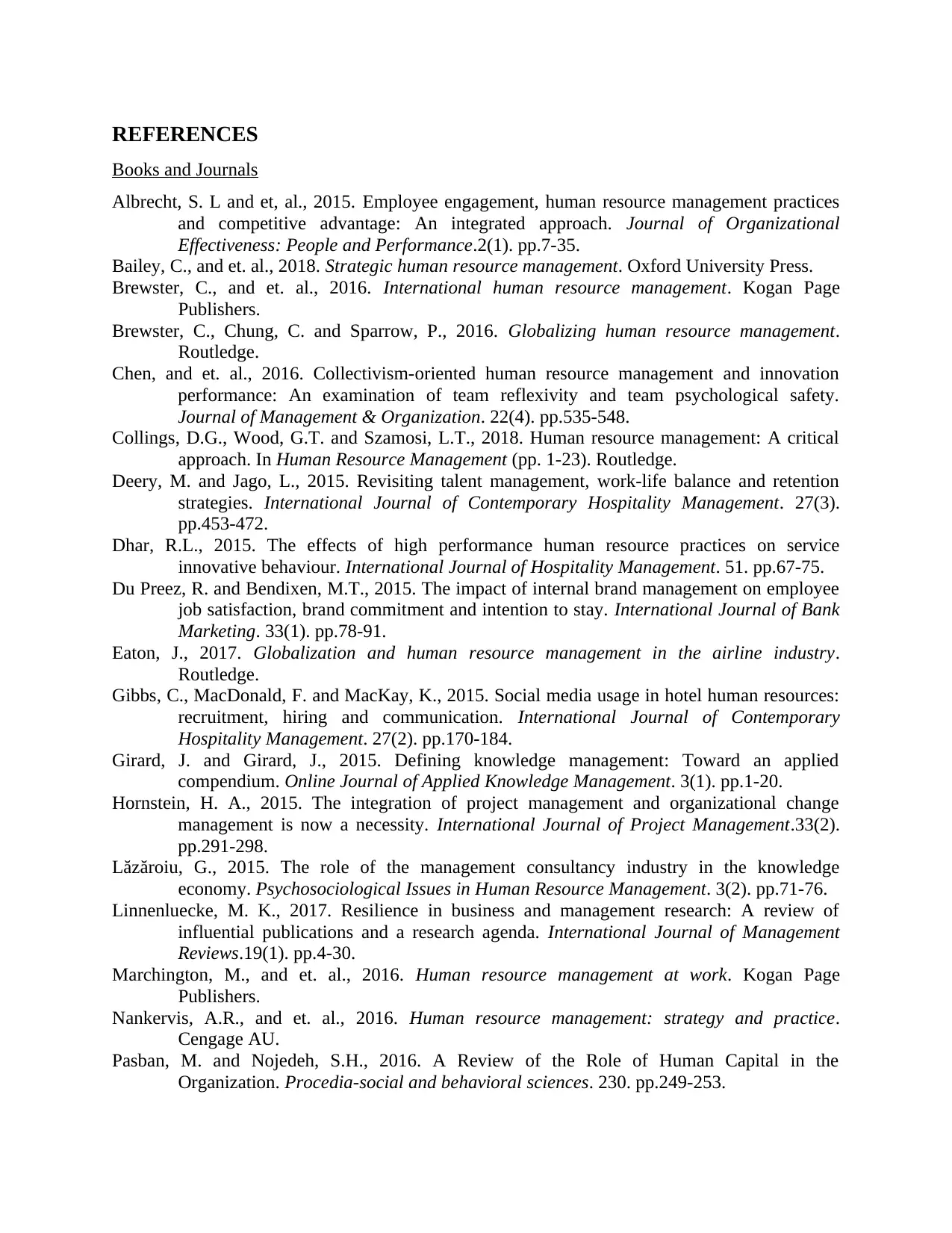
REFERENCES
Books and Journals
Albrecht, S. L and et, al., 2015. Employee engagement, human resource management practices
and competitive advantage: An integrated approach. Journal of Organizational
Effectiveness: People and Performance.2(1). pp.7-35.
Bailey, C., and et. al., 2018. Strategic human resource management. Oxford University Press.
Brewster, C., and et. al., 2016. International human resource management. Kogan Page
Publishers.
Brewster, C., Chung, C. and Sparrow, P., 2016. Globalizing human resource management.
Routledge.
Chen, and et. al., 2016. Collectivism-oriented human resource management and innovation
performance: An examination of team reflexivity and team psychological safety.
Journal of Management & Organization. 22(4). pp.535-548.
Collings, D.G., Wood, G.T. and Szamosi, L.T., 2018. Human resource management: A critical
approach. In Human Resource Management (pp. 1-23). Routledge.
Deery, M. and Jago, L., 2015. Revisiting talent management, work-life balance and retention
strategies. International Journal of Contemporary Hospitality Management. 27(3).
pp.453-472.
Dhar, R.L., 2015. The effects of high performance human resource practices on service
innovative behaviour. International Journal of Hospitality Management. 51. pp.67-75.
Du Preez, R. and Bendixen, M.T., 2015. The impact of internal brand management on employee
job satisfaction, brand commitment and intention to stay. International Journal of Bank
Marketing. 33(1). pp.78-91.
Eaton, J., 2017. Globalization and human resource management in the airline industry.
Routledge.
Gibbs, C., MacDonald, F. and MacKay, K., 2015. Social media usage in hotel human resources:
recruitment, hiring and communication. International Journal of Contemporary
Hospitality Management. 27(2). pp.170-184.
Girard, J. and Girard, J., 2015. Defining knowledge management: Toward an applied
compendium. Online Journal of Applied Knowledge Management. 3(1). pp.1-20.
Hornstein, H. A., 2015. The integration of project management and organizational change
management is now a necessity. International Journal of Project Management.33(2).
pp.291-298.
Lăzăroiu, G., 2015. The role of the management consultancy industry in the knowledge
economy. Psychosociological Issues in Human Resource Management. 3(2). pp.71-76.
Linnenluecke, M. K., 2017. Resilience in business and management research: A review of
influential publications and a research agenda. International Journal of Management
Reviews.19(1). pp.4-30.
Marchington, M., and et. al., 2016. Human resource management at work. Kogan Page
Publishers.
Nankervis, A.R., and et. al., 2016. Human resource management: strategy and practice.
Cengage AU.
Pasban, M. and Nojedeh, S.H., 2016. A Review of the Role of Human Capital in the
Organization. Procedia-social and behavioral sciences. 230. pp.249-253.
Books and Journals
Albrecht, S. L and et, al., 2015. Employee engagement, human resource management practices
and competitive advantage: An integrated approach. Journal of Organizational
Effectiveness: People and Performance.2(1). pp.7-35.
Bailey, C., and et. al., 2018. Strategic human resource management. Oxford University Press.
Brewster, C., and et. al., 2016. International human resource management. Kogan Page
Publishers.
Brewster, C., Chung, C. and Sparrow, P., 2016. Globalizing human resource management.
Routledge.
Chen, and et. al., 2016. Collectivism-oriented human resource management and innovation
performance: An examination of team reflexivity and team psychological safety.
Journal of Management & Organization. 22(4). pp.535-548.
Collings, D.G., Wood, G.T. and Szamosi, L.T., 2018. Human resource management: A critical
approach. In Human Resource Management (pp. 1-23). Routledge.
Deery, M. and Jago, L., 2015. Revisiting talent management, work-life balance and retention
strategies. International Journal of Contemporary Hospitality Management. 27(3).
pp.453-472.
Dhar, R.L., 2015. The effects of high performance human resource practices on service
innovative behaviour. International Journal of Hospitality Management. 51. pp.67-75.
Du Preez, R. and Bendixen, M.T., 2015. The impact of internal brand management on employee
job satisfaction, brand commitment and intention to stay. International Journal of Bank
Marketing. 33(1). pp.78-91.
Eaton, J., 2017. Globalization and human resource management in the airline industry.
Routledge.
Gibbs, C., MacDonald, F. and MacKay, K., 2015. Social media usage in hotel human resources:
recruitment, hiring and communication. International Journal of Contemporary
Hospitality Management. 27(2). pp.170-184.
Girard, J. and Girard, J., 2015. Defining knowledge management: Toward an applied
compendium. Online Journal of Applied Knowledge Management. 3(1). pp.1-20.
Hornstein, H. A., 2015. The integration of project management and organizational change
management is now a necessity. International Journal of Project Management.33(2).
pp.291-298.
Lăzăroiu, G., 2015. The role of the management consultancy industry in the knowledge
economy. Psychosociological Issues in Human Resource Management. 3(2). pp.71-76.
Linnenluecke, M. K., 2017. Resilience in business and management research: A review of
influential publications and a research agenda. International Journal of Management
Reviews.19(1). pp.4-30.
Marchington, M., and et. al., 2016. Human resource management at work. Kogan Page
Publishers.
Nankervis, A.R., and et. al., 2016. Human resource management: strategy and practice.
Cengage AU.
Pasban, M. and Nojedeh, S.H., 2016. A Review of the Role of Human Capital in the
Organization. Procedia-social and behavioral sciences. 230. pp.249-253.
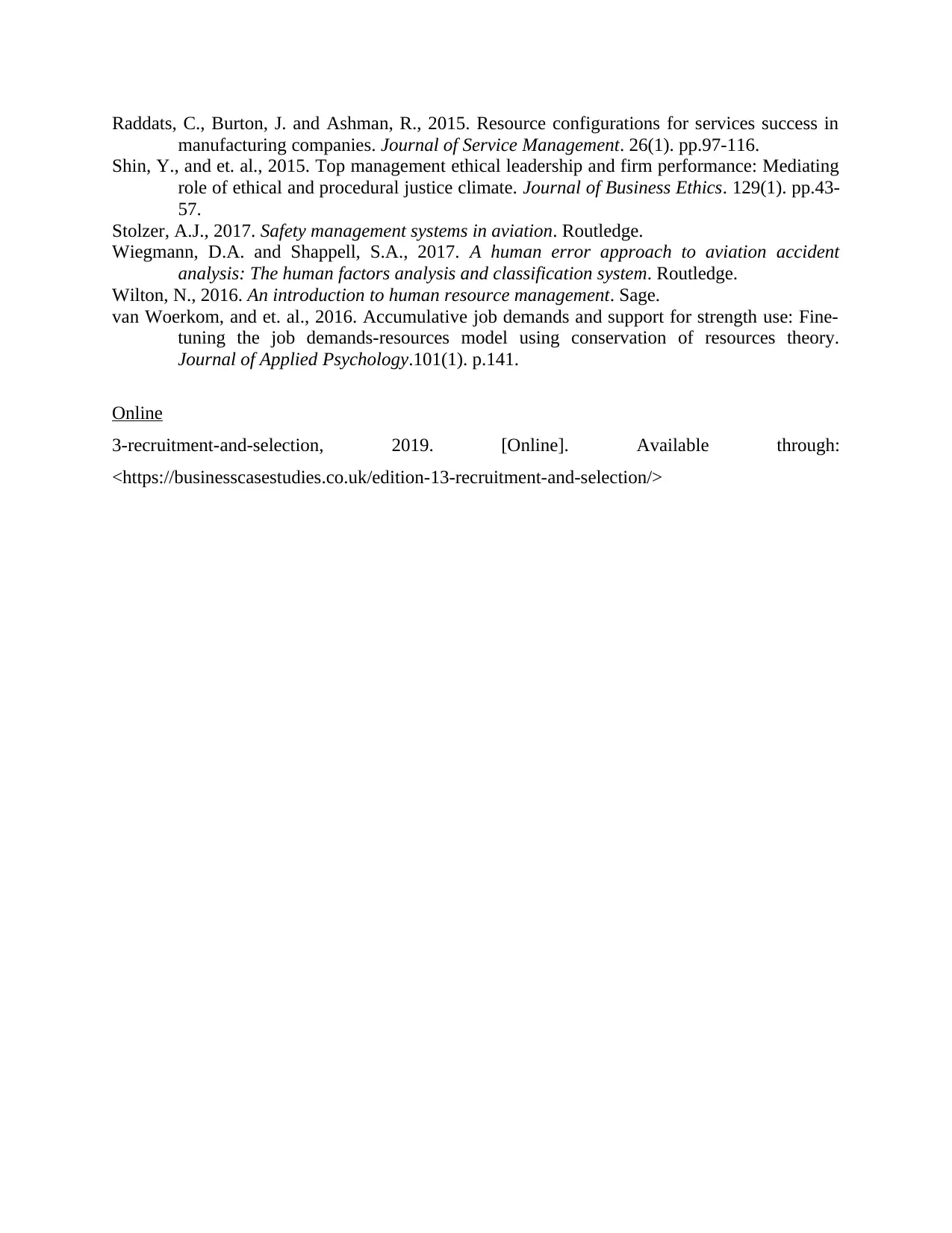
Raddats, C., Burton, J. and Ashman, R., 2015. Resource configurations for services success in
manufacturing companies. Journal of Service Management. 26(1). pp.97-116.
Shin, Y., and et. al., 2015. Top management ethical leadership and firm performance: Mediating
role of ethical and procedural justice climate. Journal of Business Ethics. 129(1). pp.43-
57.
Stolzer, A.J., 2017. Safety management systems in aviation. Routledge.
Wiegmann, D.A. and Shappell, S.A., 2017. A human error approach to aviation accident
analysis: The human factors analysis and classification system. Routledge.
Wilton, N., 2016. An introduction to human resource management. Sage.
van Woerkom, and et. al., 2016. Accumulative job demands and support for strength use: Fine-
tuning the job demands-resources model using conservation of resources theory.
Journal of Applied Psychology.101(1). p.141.
Online
3-recruitment-and-selection, 2019. [Online]. Available through:
<https://businesscasestudies.co.uk/edition-13-recruitment-and-selection/>
manufacturing companies. Journal of Service Management. 26(1). pp.97-116.
Shin, Y., and et. al., 2015. Top management ethical leadership and firm performance: Mediating
role of ethical and procedural justice climate. Journal of Business Ethics. 129(1). pp.43-
57.
Stolzer, A.J., 2017. Safety management systems in aviation. Routledge.
Wiegmann, D.A. and Shappell, S.A., 2017. A human error approach to aviation accident
analysis: The human factors analysis and classification system. Routledge.
Wilton, N., 2016. An introduction to human resource management. Sage.
van Woerkom, and et. al., 2016. Accumulative job demands and support for strength use: Fine-
tuning the job demands-resources model using conservation of resources theory.
Journal of Applied Psychology.101(1). p.141.
Online
3-recruitment-and-selection, 2019. [Online]. Available through:
<https://businesscasestudies.co.uk/edition-13-recruitment-and-selection/>
1 out of 25
Related Documents
Your All-in-One AI-Powered Toolkit for Academic Success.
+13062052269
info@desklib.com
Available 24*7 on WhatsApp / Email
![[object Object]](/_next/static/media/star-bottom.7253800d.svg)
Unlock your academic potential
© 2024 | Zucol Services PVT LTD | All rights reserved.





